IRRIGATION KEY to dairy farm’s renewable energy transition

HEAT PUMPS
helping to decarbonise meat industry
Urban Utilities
INVESTS IN MAJOR PUMP INFRASTRUCTURE
ISSUE 44 WINTER 2023

Wrapflex and Omega
Not your average pump drive

• The benchmark in Elastomeric Couplings for Pumps
• Engineered materials and patented designs to increase longevity and reduce reactive load on equipment
• Flexible enough to accommodate moderate misalignment and vibration
• Split elements for ease of in-situ replacement
• Stocked in Australia for quick and stress free access





Orange Peel®
• Coupling and Shaft Guarding
• Configurable to fit most applications
• Powdercoated steel and Polyethylene variants
• Multiple sizes and styles
• Off the shelf availability
Newcastle 02 4962 8000 | Perth 08 94124100 | Sydney 02 4677 6000 | Melbourne 03 9736 6000 | sales.australia@regalrexnord.com INDUSTRIAL POWERTRAIN SOLUTIONS
A POWERFUL PARTNERSHIP

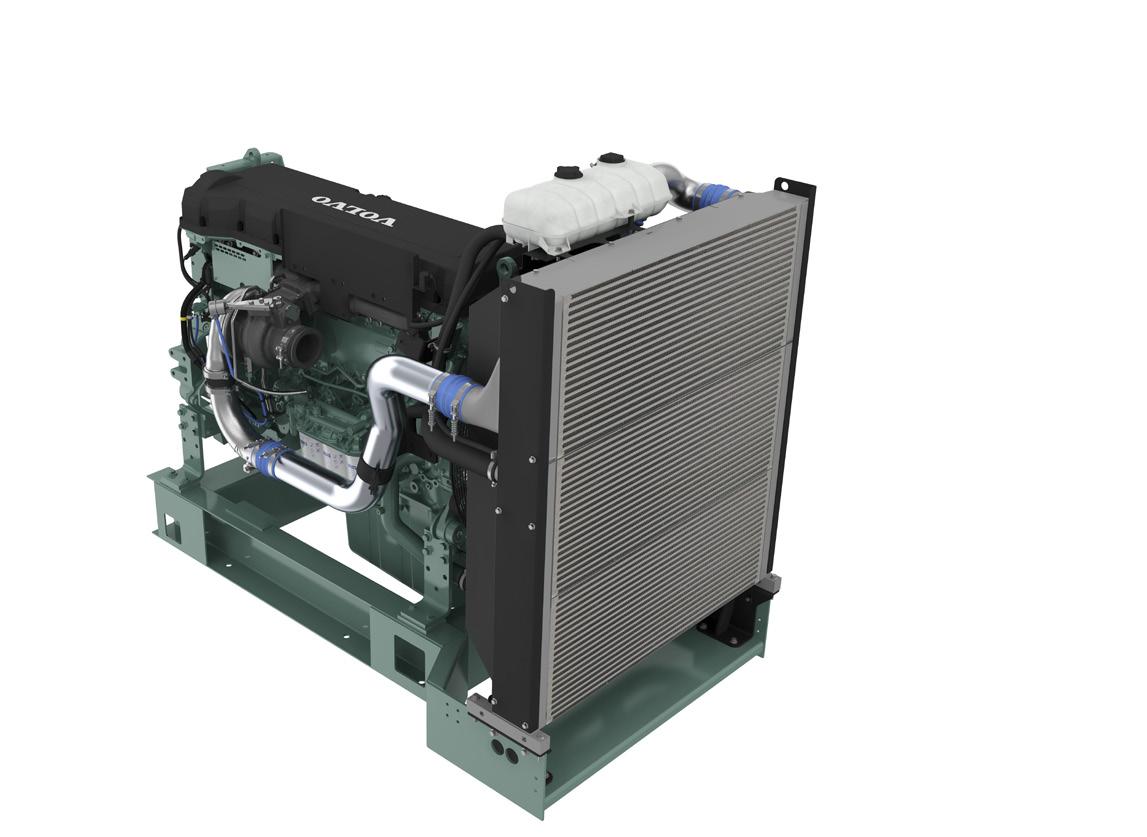
Volvo Penta. Robust, fuel efficient industrial diesel engines that keep running even in the toughest conditions. Easy to install, operate and maintain. A powerful partnership you can trust all the way from the drawing board throughout the operational life of your engine. Competitively priced complete power-pack units ready for delivery Australia wide with a local support team on hand 24/7. To find your nearest dealer visit www.volvopenta.com

105-515 KW

Hello all and welcome to the Winter Edition of Pump Industry Magazine for 2023.
As we head into the second half of the year it poses the question of whether we might see a softening in key parts of the economy. A downturn might cause a localised recession in the eastern state capitals, but nationwide mining and agriculture may keep the nation in the black.
In Q1, GDP rose 0.2 per cent marking a 2.3 per cent increase year-over-year in line with expectations with annual growth still expected to be around 1.25 per cent. All eyes will now be on the Q2 GDP results as to where the economy is headed. Unemployment sits at around 3.5 per cent, creating another problem: labour shortages.
remain in place. Not the answer we were hoping for.
So, in essence, a plumber will need to be on hand if you wish to disconnect a domestic pump to take away for repair or simply replace in accordance with the PD Act 2018.
I believe the STC does not want to fragment the PD Act by allowing other practitioners to operate in place of a plumber. It appears they don’t want to introduce grandfather clauses either as a solution.
Clearly the Act relates to plumbing and drainage work that would include anywhere there is a public health risk to the water supply, such as shopping centres, apartments blocks, etc.
Pump Industry Australia Incorporated C/-340, Stuarts Point Road Yarrahapinni NSW 2441 Australia Ph/Fax: (02) 6569 0160 pumpsaustralia@bigpond.com www.pumps.org.au
PIA Executive Council 2023
John Inkster – President Brown Brothers Engineers
James Blannin – Vice President De.mem – Stevco
Kevin Wilson – Treasury/Secretary Executive Officer
Alan Rowan – Councillor Executive Officer – Publications and Training, Life Member
Ken Kugler Executive Officer – Standards, Life Member
Steve Bosnar – Councillor Franklin Electric/Pioneer Pumps
Geoff Harvey – Councillor Irrigation Australia
Joel Neideck – Councillor TDA Pumps
Jamie Oliver – Councillor Grundfos Pumps
Mat Arnett – Councillor Ebara Pumps
Michael Wooley – Councillor Tsurumi Pumps
Billie Tan – Councillor Regent Pumps
Meanwhile the RBA is battling inflation of 6.8 per cent by lifting the cash rate to 4.1 per cent in June, the twelfth rate increase in 13 months, making it the highest it has been in the last decade. The RBA says it believes that inflation has passed its peak but remains too high. On that point I think we can expect more increases before the cycle ends.
When speaking to industry colleagues, I hear of a softening in box product for the retail and domestic markets but it appears that there is still plenty of activity in mining, municipal, infrastructure, energy and industrial markets with most commenting that they still have a reasonable pipeline of work ahead. Fortunately the diversity of our industry provides a degree of immunity to the vagaries of economic highs and lows.
The resources sector shows no sign of slowing, but there are indications that the economy will slow if not this year then maybe in the new year.
In recent editorials I have commented on the continuing dialogue with Queensland Building and Construction Commission (QBCC) and the Services Trade Council (STC) regarding the rules, interpretation and regulations covered by the PD Act 2018. As stated previously, the QBCC petitioned the STC on our behalf to consider allowing pump industry practitioners to lawfully perform work on pumps installed as part of a plumbing or drainage system.
At the time of writing, I was advised that the QBCC received a letter dated 5 June from the STC stating a decision had been made and a report was being prepared to go to the Minister of Energy and Public Works and that PIA will get a formal response in due course.
I did learn that our request, after considerable discussion by the STC, has been denied and that the status quo will
How hard this will be enforced remains to be seen, but PIA is aware of some members being given a written warning for not employing a plumber to disconnect a pump. Once we receive a formal response we can determine the next move, but I think STC will be steadfast in their decision.
On a more positive note, I see book sales of our Pump Technical Handbook and Pipe Friction Handbook have increased 82 per cent in the last 12 months, again confirming both Handbooks remain the industry standard. Our thanks to Alan Rowan for his dedicated work and research in keeping both Handbooks up to date.
Ken Kugler our Standards Officer continues to be busy in reviewing numerous ISO Standards including numerous fire related sprinkler standards. The Building Code of Australia has finally released its latest revision that now formally specifies some pump requirements that our industry has been complying with for some time.
Ken advises that he will be writing an editorial for Pump Industry Magazine as the Standards Committee CE-024 issued for public comment for ISO 5167 seeking direct adoption to become a formal Australian Standard. ISO 5167 is a suite of Flow Measurement Standards and is specified in our Pump Testing Standard AS ISO 9906:2018.
The next PIA activity is planned to be held at Link Pumps in Williamstown July/ August. John Link is a stalwart of the industry with a wealth of knowledge and an interesting pedigree when it comes to pump applications over several decades.
Thank you for your continued support of Pump Industry Australia and all the best in the coming months as we navigate a likely slowdown in the economy.
John Inkster – President
2 pump industry | Winter 2023 | Issue 44 www.pumpindustry.com.au PRESIDENT’S WELCOME



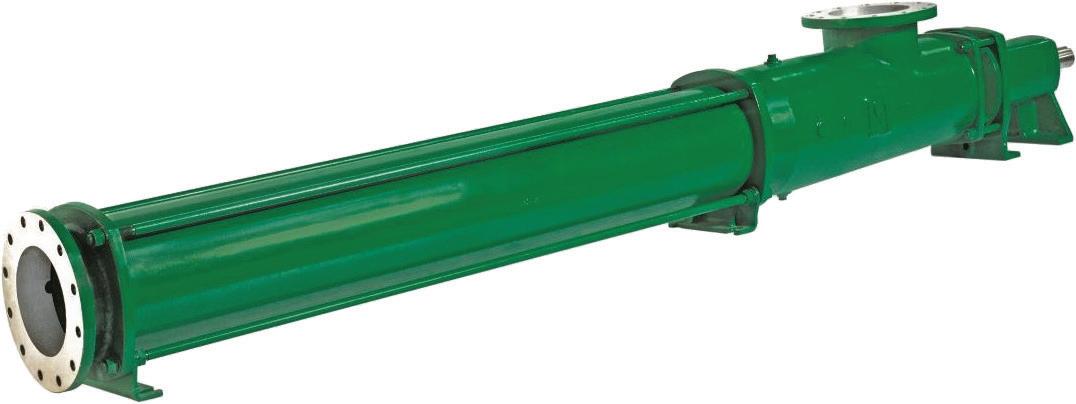


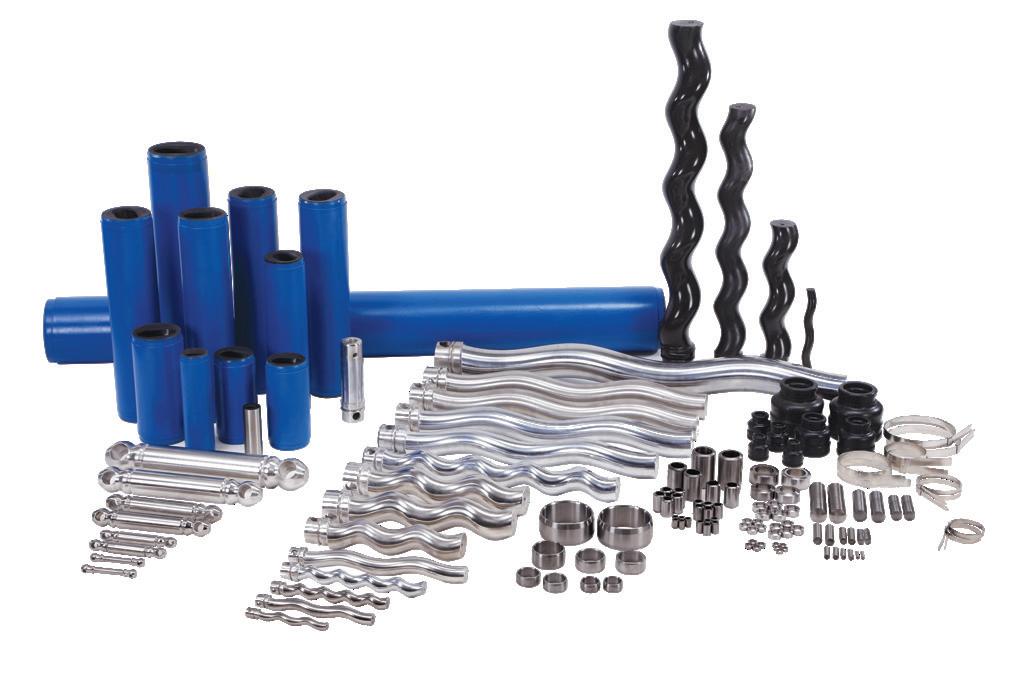
Scan to subscribe to Pump Industry Magazine’s weekly newsletter – delivered to your inbox every Thursday afternoon.
ABN: 36 426 734 954
C/- The Commons, 36–38 Gipps St, Collingwood VIC 3066 P: (03) 9988 4950 monkeymedia.com.au info@monkeymedia.com.au pumpindustry.com.au magazine@pumpindustry.com.au



Editor: Katie Livingston
Journalists: Stephanie Nestor, Tess Macallan, Steph Barker, Kody Cook
National Media Executives: Rima Munafo, Brett Thompson, Ryan Sheehan
Design Manager: Alejandro Molano
Senior Designer: Luke Martin
Designers: Danielle Harris, Ozlem Munur
Marketing Manager: Radhika Sud
Marketing Associates: James Holgate, Natalie Ta
Digital Marketing Assistants: Rhys Dawes, Bella Predika
Publisher: Chris Bland
Managing Editor: Laura Harvey
ISSN: 2201-0270
PIA MEMBER
This magazine is published by Monkey Media in cooperation with the Pump Industry Australia Inc. (PIA). The views contained herein are not necessarily the views of either the publisher or the PIA. Neither the publisher nor the PIA takes responsibility for any claims made by advertisers. All communication should be directed to the publisher.
The publisher welcomes contributions to the magazine. All contributions must comply with the publisher’s editorial policy which follows. By providing content to the publisher, you authorise the publisher to reproduce that content either in its original form, or edited, or combined with other content in any of its publications and in any format at the publisher's discretion.
CONTENTS Pumps Industry Magazine acknowledges Aboriginal Traditional Owners of Country throughout Australia and pays respect to their cultures and Elders past, present and emerging. Published by Monkey Media Enterprises NEWS Major contract awarded for Pioneer-Burdekin pumped hydro 6 $116.4M for Paradise Dam ahead of major construction .............................. 8 New Board Chair announced for Hydro Tasmania........................................ 10 Contract awarded for $150M water recycling plant upgrade ...................... 12 New research shows groundwater pumping has shifted Earth’s tilt ........... 14 Electric heat pumps to power hospital’s sustainable expansion 15 Warren Reservoir valve upgrade reveals a piece of local history 16
NEWS New AS ISO fluid flow test standards announced 17 The importance of online asset monitoring 18 Ebara Pumps releases new GSO model process pump 20 This
produced to international environmental management standard ISO14001 by a certified green printing company.
document has been


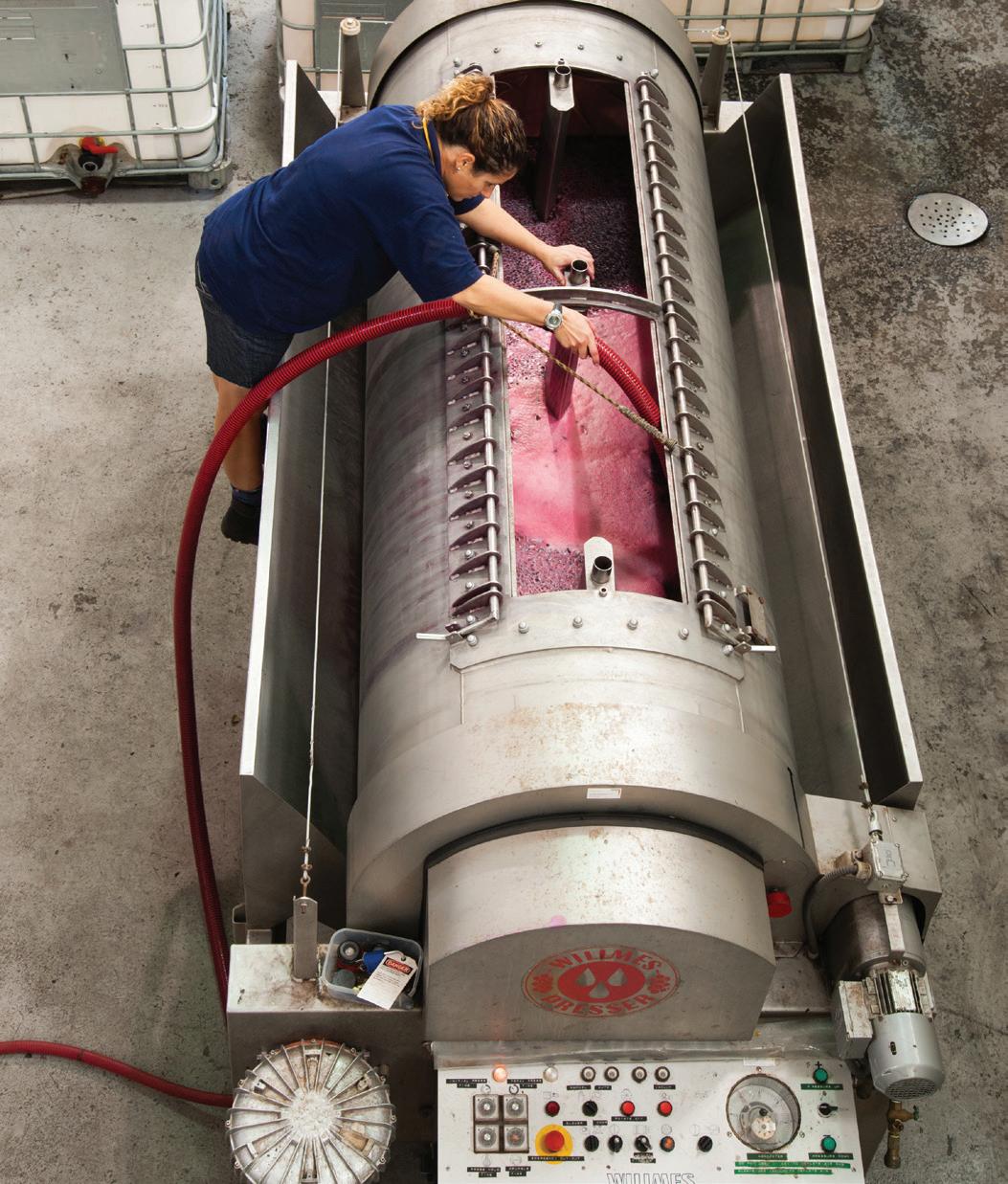
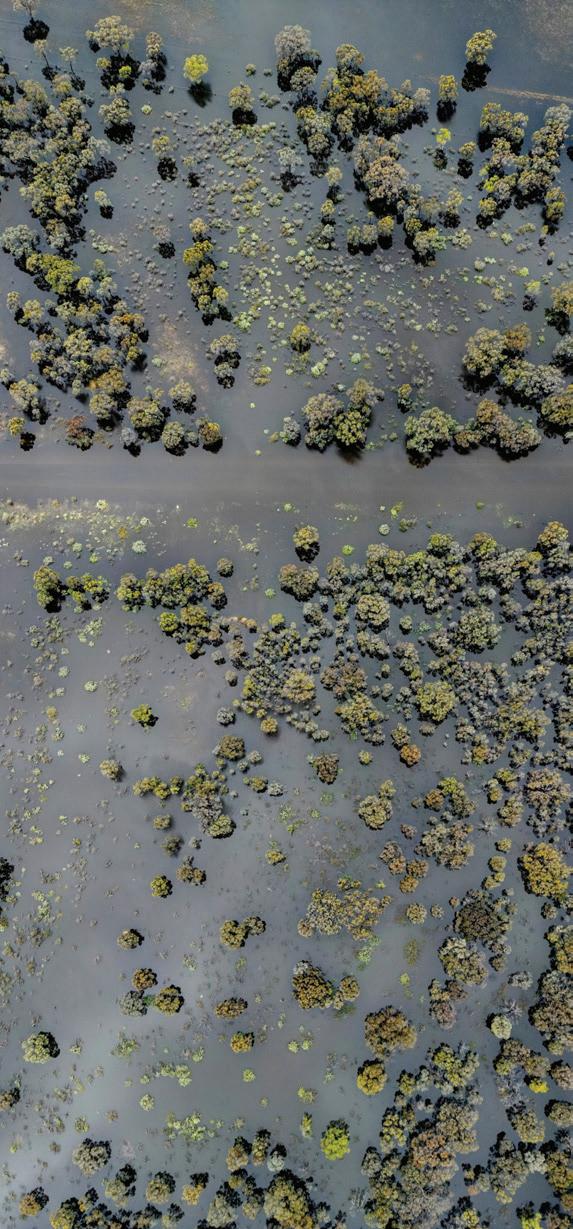

5 www.pumpindustry.com.au pump industry | Winter 2023 | Issue 44 MINING Carbon capture in the NT 22 Exploring Beetaloo’s fracking frontier ........................ 26 INDUSTRY MARKETING Content marketing 101 for the pump industry 30 IRRIGATION Irrigation overhaul: how pumps helped a dairy farm’s renewable energy transition 34 MANUFACTURING Going electric: the opportunity for heat pumps in industry 42 INSTRUMENTATION AND MONITORING Go with the flow – choosing the right type of flow measurement 46 FOOD Pump the grapes: the careful balance of wine pumps 48 Hot stuff: how heat pumps can help decarbonise the meat processing industry 52 PROJECT Hay Shire’s pumping flood recovery 56 Urban Utilities invests $65M in major pump infrastructure 58 PUMP HANDBOOK Intake design – part 1 60 REGULARS President’s welcome ........................................................2 ASK AN EXPERT Progressive cavity pumps in the mining industry ....... 38 PUMP SCHOOL What are the solutions to pump cavitation? 40 Editorial schedule 64 Advertisers’ index ......................................................... 64

Major contract awarded for PIONEER-BURDEKIN PUMPED HYDRO
The Queensland Government has awarded a major contract on the Pioneer-Burdekin pumped hydro energy storage project to a local family business from the Mackay region.
Twin Hills Engineering and Drilling was announced as the successful tender for the six-month geotechnical shallow drilling program, which will be used to inform the project design and will be a fundamental part of the development of this nation-building project.
Supporting more than 3,000 jobs during the peak of construction, the proposed scheme is expected to provide the world’s biggest pumped hydro energy storage with 5GW of clean, reliable, and affordable power supply and storage to Queenslanders over a 24-hour period.
Pumped Hydro Energy Storage is a proven technology that is a foundational investment in Queensland’s SuperGrid to provide 24/7 clean and reliable power.
The Pioneer-Burdekin project is proposed to generate 5000MW for 24 hours, equivalent to around half of the entire state’s peak usage.
Pumped hydro acts like a giant water battery:
• It uses electricity from the grid or nearby renewables to pump water from a lower reservoir into an upper reservoir when energy prices are low
• When energy is needed, water is released from the upper reservoir into the lower reservoir, generating energy as it passes through a turbine
• Hydroelectricity can be generated almost immediately and at any time, so power can be fed into the grid when it is needed
A Queensland-based joint venture with a strong presence in Mackay, Water2Wire was also announced as the successful proponent for the project’s Front-End Engineering and Design (FEED), as part of the Queensland Energy and Jobs Plan Member for Mackay, Julieanne Gilbert, said this is an exciting major project for the region that will mean business opportunities for local companies and thousands of jobs for
locals – whether it’s electricians and technicians, suppliers of building materials, or drillers and engineers like these two contracts.
“Pumped hydro energy storage and clean energy will provide another lane on Mackay’s industrial superhighway with thousands of locals who stand to benefit from it,” Ms Gilbert said.
Queensland Minister for Energy, Renewables and Hydrogen, Mick de Brenni, said the Pioneer-Burdekin Pumped Hydro Project is the cornerstone of the Queensland Energy and Jobs Plan, and will be the largest pumped hydro scheme in the world.
“This mega pumped hydro project will act like a giant battery, and when connected to our Queensland SuperGrid, will underpin the reliability of our publicly owned grid by storing the energy generated by our renewable energy zones,” Mr de Brenni said
“The project is poised to offer hundreds of supply chain opportunities, and with application of the Palaszczuk Governments’ signature Buy Queensland Procurement Policy, local businesses like Twin Hills and Water2Wire will be the preferred project partners.
“It’s regions like Mackay that are at the centre of Queensland’s renewable energy transformation – which will unleash new industrial jobs in hydrogen, renewables, manufacturing, and critical minerals.”
Queensland Hydro CEO, Kieran Cusack, said with Water2Wire’s recent work on high-profile projects like Borumba and Kidston, and their collective expertise in delivering pumped hydro projects around the world, they will be a great asset to this project.
“We are looking forward to working with them on this worldclass project,” Mr Cusack said.
“We’re also delighted to be working with a local family business employing local workers that has been awarded the first geotech drilling contract for Queensland Hydro’s PioneerBurdekin project.”
6 pump industry | Winter 2023 | Issue 44 www.pumpindustry.com.au
NEWS
















Dam

$116.4 million has been allocated to the pre-construction activities of the Paradise Dam Improvement Project, which includes work to replace the dam’s irrigation valves.
These major dam improvement works will deliver long-term water security for the Bundaberg region by restoring the dam’s capacity and will improve the dam’s resilience against major flooding and extreme weather events.
This rebuild will support around 250 jobs during construction and will, once back to full operation, deliver significant flow-on benefits for local businesses and Bundaberg’s regional economy.
Federal Minister for Water, Tanya Plibersek, said water is one of our country’s most precious resources.
“The Albanese Labor Government knows how important rebuilding the Paradise Dam is to provide water security and drive economic growth in Queensland’s food bowl of Bundaberg,” Ms Plibersek said.
“That’s why we are investing $600 million towards the Paradise Dam Improvement Project.
“I look forward to continuing working in partnership with the Queensland Government to build a secure water future for all Queenslanders.”
Sunwater is progressing procurement, design development and approval activities to prepare for site mobilisation ahead of major construction commencing in late 2024.
Outlet works to replace the dam’s irrigation valves are expected to be completed by August 2023.
Queensland Premier, Annastacia Palaszczuk, said this is an investment in long-term water security and local jobs for regional Queensland.
“Rebuilding Paradise Dam will provide future certainty for local growers – as well as ensuring a safe and secure water supply across the region for generations,” Ms Palaszczuk said.
“This is one of the largest construction projects in the history of the Bundaberg region and it will ensure water security for the farmers, industry, and the broader community is safeguarded for decades to come.”
Treasurer and Minister for Trade and Investment, Cameron Dick, said this complex infrastructure project delivered in a live operational environment is a major and vital undertaking.
“When completed the Paradise Dam Improvement Project will return the dam to its full 300,000ML capacity and will provide a safe, reliable and secure water
supply to local agricultural, industrial and urban communities,” Mr Dick said.
“The strength of this year’s Budget gives us the ability to make the investments necessary to ensure Queensland’s continued prosperity.”
Minister for Regional Development and Manufacturing and Minister for Water, Glenn Butcher, said returning Paradise Dam to its original capacity and getting jobs on the ground for the region is a priority for the Queensland Government.
“This is why it is an important item in the Big Build, ensuring water security for the region.
“A rebuilt Paradise Dam is a vote of confidence for the farmers and industry in the Bundaberg and Burnett region – and it will undeniably unlock new economic opportunity,” Mr Butcher said.
Member for Bundaberg Tom Smith, said this is a critical step on the path to fixing Paradise Dam and one that will benefit and support local growers.
“We know that a reliable water supply is a key ingredient for continued growth and prosperity for our region – which is one of the most important food bowls in the country.
“I’m proud that Bundaberg workers will play an important role in delivering this project.”






8 NEWS
52 Woodlands Drive, Braeside Victoria 3195 PO Box 876, Braeside Victoria 3195 Tel: (03) 9588 6900 Fax: (03) 9588 6999 Email: info@lkdiesel.com.au Web: www.lkdiesel.com.au • Petrol engines up to 13 HP • Diesel engines up to 83 HP • Generating sets up to 30 KVA We provide diesel engine solutions to EMPOWER your business WATER PUMPS ALSO AVAILABLE
for
pump industry | Winter 2023 | Issue 44 www.pumpindustry.com.au
$116.4M
Paradise
AHEAD OF MAJOR CONSTRUCTION
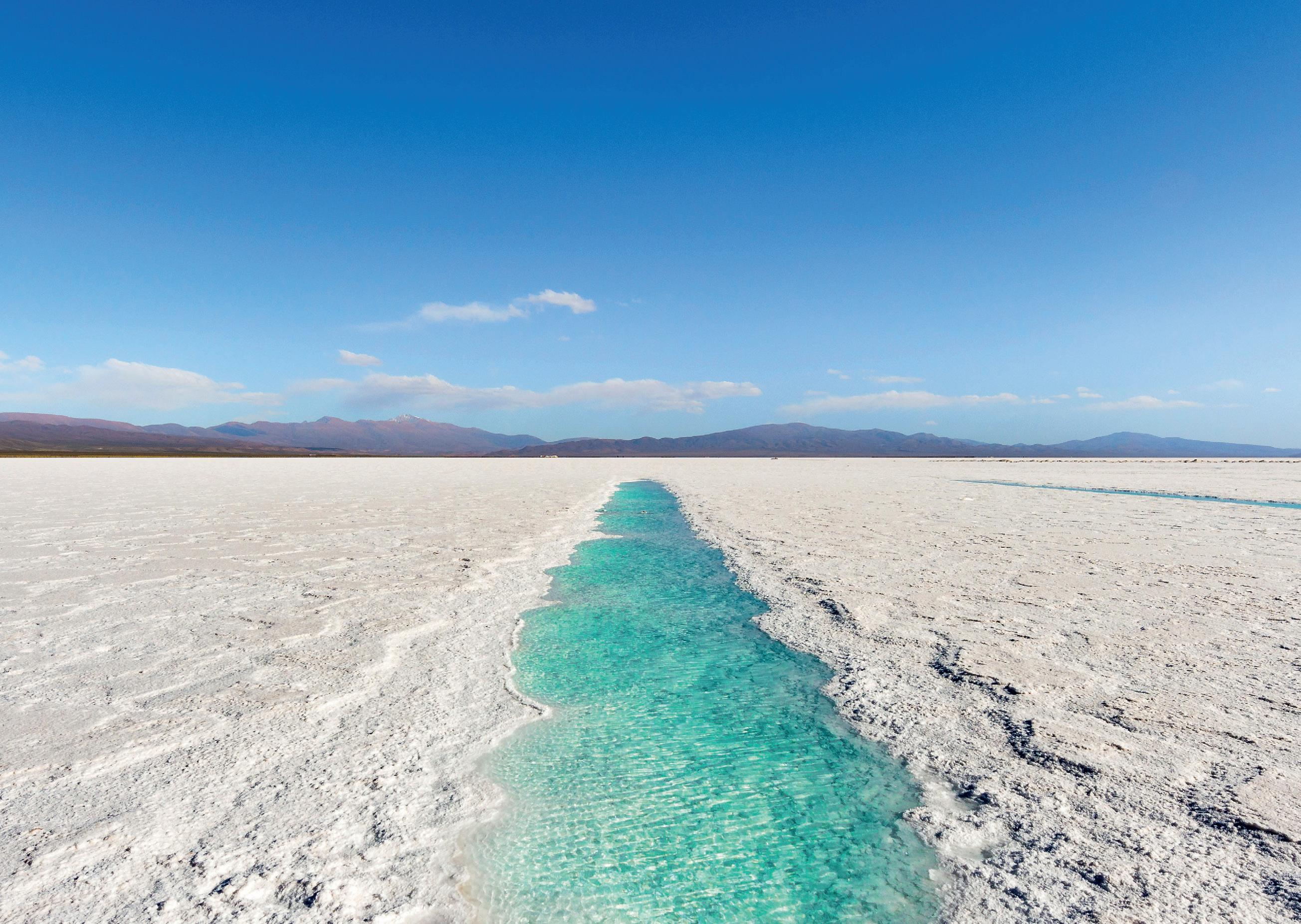
Climate
population growth, and water scarcity are creating new challenges, and desalination is becoming an important alternative to traditional freshwater resources.

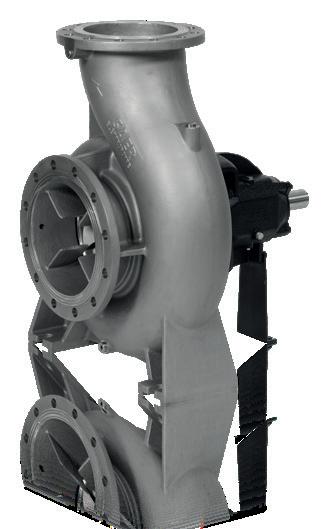
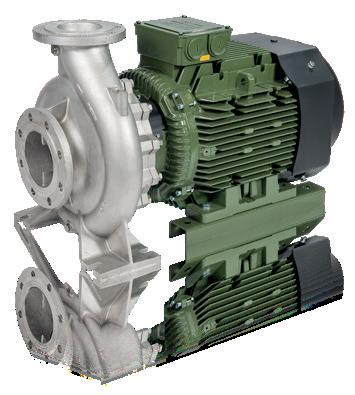





Are you ready?
MADE IN ITALY SAER ELETTROPOMPE S.p.A. � Via Circonvallazione, 22 42016 Guastalla (RE) - Italy � +39 0522 830941 � info@saer.it � saerelettropompe.com � SAER.Elettropompe � saerelettropompe � Saer Elettropompe DUPLEX SUPER DUPLEX
change,
face these new scenarios with a strong
fast answer: a full range of high efficiency end suction, close coupled, high pressure, split casing
submersible pumps
motors in DUPLEX
SUPER DUPLEX
of
best delivery time
the market, thanks to the italian production.
the water management in civil, industrial, marine
agricultural water services
rest assured with SAER quality.
Use our SAER pump selector to find out your solution
SAER is ready to
and
and
and
and
, available with one
the
on
Let’s improve
and
and
#saerready

New Board Chair announced FOR HYDRO TASMANIA
Hydro Tasmania has appointed Richard Bolt as its new Chair of the Board.
Mr Bolt has worked in both public and private sectors, leading major innovation and reform across industries including energy, resources, agriculture, education, economic development and transport. He was a leading architect of the national energy market’s governance systems.
Hydro Tasmania Chief Executive Officer, Ian Brooksbank, said senior executives look forward to working

closely with Mr Bolt over a period of growth for Hydro Tasmania.
“We have a bold vision for the role of hydro energy in powering the Tasmanian economy and in leading the national transition to renewable energy,” Mr Brooksbank said.
“Mr Bolt’s incredible knowledge and track record in the energy sector will be invaluable in charting that course.”
Mr Brooksbank paid tribute to outgoing Chair, Grant Every-Burns, who has been on the Hydro Tasmania Board since 2012 and in the role of Chair since 2014.
“An electrical engineer by trade, Mr Every-Burns knows every corner of the energy industry,” Mr Brooksbank said.
“He steered the company through an enormous shift in the energy sector and his passion for Tasmania as the battery of the nation has put the state in prime position to capitalise on that transition.”
Mr Brooksbank also acknowledged Mr Every-Burns’ calm and steady leadership throughout 2015 and 2016, when the Basslink outage combined with drought posed significant challenges for energy supply in Tasmania.
10 pump industry | Winter 2023 | Issue 44 www.pumpindustry.com.au NEWS DELIVERING PUMPING SOLUTIONS 05/23 Ph: 1300 4 BBENG www.brownbros.com.au The most comprehensive range of pumps and innovative pumping solutions. Contact us to see how we can deliver your pumping solution.

The missing link in your B2B Marketing Strategy
While traditional trade publications have quality audiences and high levels of trust, they can lack the full range of services to guarantee a return on your investment. And while traditional marketing agencies offer the latest marketing techniques, they don’t have the audience or the industry understanding the B2B sector needs.
Monkey Media is the missing link that brings together a trusted brand and powerful audience, with a complete agency offering.
TO FIND OUT MORE SCAN THE QR CODE NOW
Contract awarded for $150M water recycling plant upgrade
Sydney Water has awarded a contract to deliver $150 million of upgrades to the Richmond Water Recycling Plant (WRP) to improve its wastewater network, which includes the construction of a new pump station.
BMD Constructions will deliver the project, which is expected to double the plant’s capacity. The contract includes upgrades to the 7km main that transfers flows from North Richmond to Richmond, construction of a new wastewater pumping station, and upgrades to the three existing wastewater facilities in the area.
Sydney Water Senior Project Manager, Greg Cable, said the planned works will play a major part in ensuring a more sustainable future, meeting the needs of Richmond’s growing population.
the completed upgrades will help future-proof the region’s rapidly growing population over the next three decades,” Mr Cable said.
“This project will also contribute significantly to circular economy benefits by expanding water recycling capacity at the site and the production of biosolid matter for reuse.”

“Growth is set to increase by 70 per cent, and we estimate
BMD Constructions General Manager, John Vida, said the contract is an exciting opportunity to work with Sydney Water to deliver wastewater upgrades that will benefit the area for decades to come.
“We’re looking forward to maximising our collaborative partnership with Sydney Water and together bolstering outcomes to benefit the people of Sydney,” Mr Vida said.
Construction of the Richmond WRP will commence in September 2023 and is scheduled to be completed by 2026.
Innovative solutions to solve your environmental pollution problems
MAIRS Technology uses traditional technologies and innovative engineered solutions to service a range of industries and customers to help manage their environmental needs and systems, whilst meeting environmental and health safe regulations, and health of nearby communities.
Our capabilities:
• Project Management Services
• Engineering Service Support
• Equipment Spares Supply
• Construction services and supervision
• Sub-contract management
• Commissioning and training
• Asset inspections and reports
• Asset maintenance and management planning
• Optimisation and system improvements


03 9028 8080 sales@mairstech.com www.mairstech.com
NEWS


RAINWATER RE-USE AND WATER BOOSTING SYSTEMS
Built to suit your needs
Custom made rainwater re-use, and water boosting system. Maxijet Australia is committed to manufacturing the best pump systems for water conservation.
Available in many configurations to suit your flow requirements or any project specifications.
All manufactured locally in our Melbourne factory allowing for quicker lead times to meet required delivery dates.




Additional Options
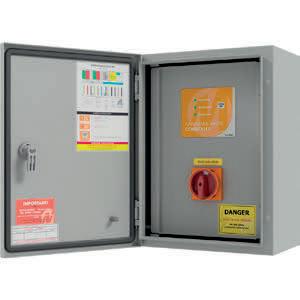








Protective Cover Design

• Full Cover Removal
• Cover is Optional
• Made with ALPOLIC™/fr
• Fire Retardant
• 2 Year Warranty
• Representational Image Only


Address: 32 McGregors Drive, Keilor Park Vic 3042 Email: sales@maxijet.com.au Web: www.maxijet.com.au Phone: 03 9336 1000 Fax: 03 9336 1099
Specifications
Built
Trusted Quality
Domestic,
Agricultural Applications
Trusted Quality and Service Built to Suit
Made Locally,
In-house
Suitable for Commercial,
and
VSD Controller Submersible Option Anti Tamper/ Weather Cover Suction Strainer
NEW RESEARCH SHOWS groundwater pumping has shifted Earth’s tilt

Humans have shifted such a large mass of water that the Earth tilted nearly 80cm east between 1993 and 2010 according to a new study published in Geophysical Research Letters, AGU’s journal for short-format research.
The movement, caused by groundwater pumping, has implications spanning the Earth and space sciences.
Based on climate models, scientists previously estimated humans pumped 2,150Gt of groundwater – equivalent to more than 6mm of sea level rise – from 1993 to 2010. However, validating this estimate is difficult.
One approach lies with the Earth’s rotational pole, which is the point around which the planet rotates. It moves during a process called polar motion, which is when the position of the Earth’s rotational pole varies relative to the crust. The distribution of water on the planet affects how mass is distributed. Like adding a tiny bit of weight to a spinning top, the Earth spins a little differently as water is moved around.
Seoul National University geophysicist Ki-Weon Seo, who led the study, said, “Earth’s rotational pole actually changes a lot. Our study shows that among climate-related causes, the redistribution of groundwater actually has the largest impact on the drift of the rotational pole.”
Water’s ability to change the Earth’s rotation was discovered in 2016, and until now, the specific contribution of groundwater to these rotational changes was unexplored. In the new study, researchers modelled the observed changes in the drift of Earth’s rotational pole and the movement of water – first, with only ice sheets and glaciers considered, and then adding in different scenarios of groundwater redistribution.
The model only matched the observed polar drift once the researchers included 2,150Gtons of groundwater redistribution. Without it, the model was off by 78.5cm, or 4.3cm of drift per year.
Mr Seo said, “I’m very glad to find the unexplained cause of the rotation pole drift. On the other hand, as a resident of Earth and a father, I’m concerned and surprised to see that pumping groundwater is another source of sea-level rise.”
Jet Propulsion Laboratory Research Scientist
Surendra Adhikari said, “This is a nice contribution and an important documentation for sure. They’ve quantified the role of groundwater pumping on polar motion, and it’s pretty significant.”
The location of the groundwater matters so researchers can discover how much it could change polar drift; redistributing water from the midlatitudes has a larger impact on the rotational pole. During the study period, the most water was redistributed in western North America and northwestern India, both at midlatitudes.
Countries’ attempts to slow groundwater depletion rates, especially in those sensitive regions, could theoretically alter the change in drift, but only if such conservation approaches are sustained for decades, Mr Seo explained.
The rotational pole normally changes by several metres within about a year, so changes due to groundwater pumping don’t run the risk of shifting seasons. But on geologic time scales, polar drift can have an impact on climate, Mr Adhikari said.
The next step for this research could be looking to the past.
“Observing changes in Earth’s rotational pole is useful for understanding continent-scale water storage variations. Polar motion data are available from as early as the late 19th century. We can potentially use that data to understand continental water storage variations during the past 100 years. Were there any hydrological regime changes resulting from the warming climate? Polar motion could hold the answer,” Mr Seo said.
14 pump industry | Winter 2023 | Issue 44 www.pumpindustry.com.au
NEWS
Electric heat pumps to power hospital’s sustainable expansion
The first of 21 large heat pumps has been delivered to the Canberra Hospital’s Critical Services Building site, as part of the facility’s new expansion.
The heat pumps are one of the fundamental features of the new all-electrical building, replacing traditional gas boilers as the building’s source of hot water.
The new Critical Services Building showcased its environmentally sustainable credentials for World Environment Day, with the building targeting a five-star Green Star rating.
ACT State Minister for Health, Rachel Stephen-Smith, said the Canberra Hospital expansion project is leading the way nationally in environmentally sustainable health infrastructure design.

“The Critical Services Building will be Australia’s first allelectric major hospital building and when it opens in 2024 it will mitigate the release of an estimated 1,886t of carbon emissions each year, the equivalent of removing 760 cars from Canberra’s roads.
“We are building on that momentum by targeting a five-star Green Star rating for the new Critical Services Building. This incorporates the latest environmentally sustainable design features such as a high performing façade and new technology that automatically monitors and controls heating, ventilation and cooling,” Ms Stephen-Smith said.
Key features of sustainable design in the Critical Services Building to target an enhanced Green Star rating include:
A high-performing façade glazing of thermally-broken double glazed units, which minimises the cooling required in summer and heating required in winter, and other energyefficient façade elements
Energy efficient and intelligent HVAC systems
• A holistic Building Management and Control system, which monitors and controls all systems in the building
• A high indoor environment quality
• Landscaping and irrigation that uses recycled water and open courtyards and green spaces with plants suitable to the local environment
• Environmentally conscious decision-making, which has been at the forefront of the Critical Services Building throughout its construction process
• During demolition of the previous buildings that stood on site, with 96 per cent of the materials salvaged and repurposed for other projects
Concrete for the new building includes locally sourced low carbon concrete, a 40 per cent reduction in carbon content when compared with standard concrete mixes, and has eliminated more than 2,000t of embodied CO² on the project to date – the equivalent of carbon removed by more than 30,000 tree seedlings grown over ten years.
The use of electric cranes has also helped to eliminate pollution and noise during building construction.

Leading fluid path solutions provider expands Australian presence with new Perth office
Watson-Marlow Fluid Technology Solutions (WMFTS) is celebrating the opening of its new Perth office, the company’s second in Australia.
Previously operating solely out of its Sydney office, WMFTS has been a leading provider of fluid path solutions for the past 13 years. This new Perth office brings the Watson-Marlow team closer to its Western Australia-based customers so that it can further enhance its quality of service.

This new Perth base is located in Belmont, and is focused on directly supporting, selling, servicing and repairing WMFTS solutions.
Elie Elazar, Country Manager at Watson-Marlow Australia, said, “We’re delighted to strengthen our presence in the market with the opening of our second office in Perth. We put the customer at the heart of everything we do and with our Perth site, we are making sure that we can truly partner with them on their fluid path challenges.”
15 www.pumpindustry.com.au pump industry | Winter 2023 | Issue 44
For further information please contact us: Watson-Marlow Fluid Technology Solutions +61 8 6156 7555 / +61 2 8787 1400 info.au@wmfts.com NEWS
Warren Reservoir valve upgrade reveals a piece of local history

SA Water’s recent $8 million upgrade of the intake and scour valves at Warren Reservoir’s dam has revealed a piece of local history –the Second South Para Bridge emerged from the water’s depths for the first time since the reservoir was initially filled more than 100 years ago.
Built in 1890, the 20-metre-long bridge provided a shorter crossing over the South Para River within the original family property of the reservoir’s namesake – John Warren.
As part of the upgrade, Warren Reservoir reached zero per cent of its capacity following a five-week drawdown of the water level, to enable safe access for crews to the base of the dam wall.
SA Water’s Senior Manager of Capital Delivery, Peter Seltsikas, said the generally intact 133-year-old bridge was a rare and unexpected sight arising from the valve upgrade.
“The discovery only came to light when the local Williamstown and Districts Historical Society reached out to inform us that one of their members recalled a bridge that had become slightly visible during the 1960s drought,” Mr Seltsikas said.
“After the tip off, we conducted sonar testing while the reservoir was at 16 per cent capacity and detected a structure at the bottom of the water resembling a bridge.
“We have since learned it was originally built on the family property of John Warren – a former councillor and member of the Legislative Council, who the reservoir is named after – with the entire structure fully resurfacing for the first time since it was flooded by the reservoir’s filling.”
Mr Seltsikas said the deck, pylons and substructure appear to be mainly intact, and it’s likely the white sections of the parapet have washed away over time.
“Despite it no longer carrying a horse and cart over the old river, it’s helped provide habitat and shelter for the reservoir’s fish as we’ve caught a large number in and around the bridge during our relocation activities,” Mr Seltsikas said.
As part of the water level’s gradual lowering, around 4.5t of the reservoir’s native fish and turtles have been relocated to the nearby South Para Reservoir, including species like Bony
Mr Seltsikas said with the reservoir now empty, crews were ramping up to start major construction work as part of replacing the dam’s valves.
“Upgrading the intake and scour valves ensures water can be safely transferred from the reservoir and supplied to our customers into the future,” Mr Seltsikas said.
“With the last of the reservoir’s water released early May 2023, crews are set to begin installing a causeway and swing stage scaffolding to safely access the dam wall to decommission the existing valves.
“The valves are connected to a power house near the top of the dam wall and enable water to be transferred from the reservoir to customers for irrigation.
“Two new butterfly valves – which utilise a rotating disc to regulate flow –and a sluice gate scour will be lifted into place with a 220t crane and connected to the existing pipework, and once completed, the valves can be operated automatically from access platforms installed on the dam crest.”
16 pump industry | Winter 2023 | Issue 44 www.pumpindustry.com.au NEWS
Bream, Murray Cod, Golden Perch and Silver Perch.
NEW AS ISO FLUID FLOW test standards announced
The Standards Australia Committee CE-24 recently issued a suite of draft AS ISO Flow Measurement Standards for public comment.
ISO standard 5167 has seven parts and covers the measurement of fluid flow by means of pressure differential devices inserted in circulation crosssection conduits running full. The various pressure differential devices covered include nozzles and venturi nozzles, orifice plates, venturi tubes, cone meters, and wedge meters.
These AS ISO 5167 standards are expected to be published within the next two months and will be direct adoptions of the current ISO standards. For the record, in the past an Australian Standard that was a direct adoption of an ISO standard was known by a separate AS number, the ISO number was secondary. ISO 5167 is included in the bibliography of the pump test standard AS ISO9906:2018 and the fire pump standard AS2941-2013.


SANDPIPER EVOLUTION and SIGNATURE series
Engineered to deliver industry leading durability and performance, for even the most severe and demanding mining environments.
Durable and portable pumps suitable for: - Dewatering
- Fuels and lubricants
- Refining, smelting and milling process
- Water treatment
We know the importance of choosing the right equipment to match your process. With our extensive range of pumps, first class customer service and ongoing comprehensive support, Kelair Pumps are second to none when it comes to your pumping requirements.
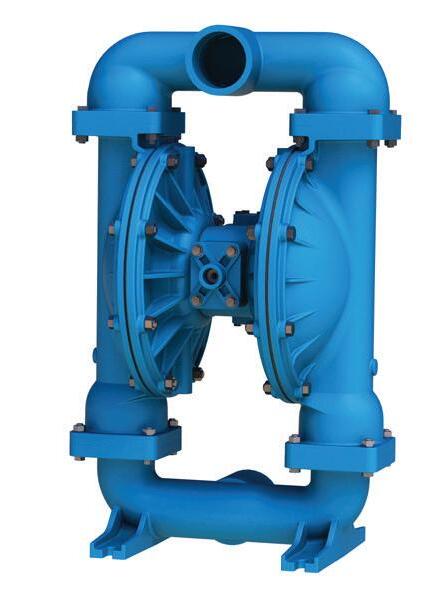







17 www.pumpindustry.com.au pump industry | Winter 2023 | Issue 44 PIA MEMBER NEWS WHEN PUMP KNOWLEDGE MATTERS Rely on Kelair Find out more today 1300 789 466 www.kelairpumps.com.au Heavy Duty Flap Valve Pumps Heavy Duty Ball Valve Pumps Standard Duty Ball Valve Pumps The Beast Heavy Duty, Clog Resistant Flap Valve Pumps
05/23
THE IMPORTANCE OF ONLINE ASSET MONITORING

Unplanned production downtime is one of the key reasons for lost productivity and profitability in a sector. Corrective maintenance events can be avoided by continually monitoring machine parts and equipment online.
With the help of hardware for data collecting, gateways for transmission to the cloud, software for data visualisation and sophisticated analysis, and operational and maintenance staff, the WEG Motion Fleet Management solution is a high-level tool for managing and monitoring industrial fleets. With WEG Motion Fleet Management, a well-planned predictive maintenance methodology can be implemented while keeping an eye on the asset's operational state.
Online asset condition monitoring has a big impact on how well operational and maintenance resources are used, including spare parts management, increased asset availability, and the reduction of both direct and indirect costs.
Since a sudden breakdown typically results in stress and deterioration of the equipment's mechanical and electrical components, methods of this kind also help to extend asset lifetime.
Smart condition monitoring to your fleet
WEG Motion Fleet Management is designed to be the best way to keep track of and improve the availability of the industrial fleet. It was created to bring more practicality and agility to the operation, maintenance, and management of industrial facilities. Asset monitoring is possible at any time and from any location thanks to cloud computing technologies.
The operating status of low and medium voltage motors and drives (inverters and soft-starters), gearboxes, gearmotors, compressors, and other assets used in any industry or installation can be determined with the help of the WEG Motion Fleet Management. Valuable insights are produced by routine data gathering and sophisticated data processing, both at the edge and in the cloud.
By keeping an eye on how the fleet is operating, predictive maintenance plans can be created (conditionbased maintenance).
With this strategy, fewer unplanned stops occur, repair actions are optimised, and the operation and maintenance team's decision-making process is sped up. The drive fleet will eventually have greater availability and lower total cost of ownership (TCO).
Advantages and benefits of the WEG Motion Fleet Management Solution:
• Ability to monitor several assets and plants in a single environment
• Ecosystem in constant development, both hardware and software
• Fleet management view with reports and indicators
• Ready-to-use solution, just register the WEG Scans in the application and use it
• Customised layouts for navigation at various levels (geolocation, site, plant, device)
• Definition of favourite assets for easy tracking of their status
• Daily notifications of assets in alert and/or critical state (via email)
• Customisation of tolerances to generate alerts and notifications
• Enables maintenance management based on the operational condition of the assets
• Dashboards with indicators, graphics, and history of measured data
• Screens for user and subscription management
• Flexible solution available to service providers
• Operational cost reduction (TCO, total cost of ownership)
• Multi-language application
18 pump industry | Winter 2023 | Issue 44 www.pumpindustry.com.au
PIA MEMBER NEWS | SPONSORED EDITORIAL
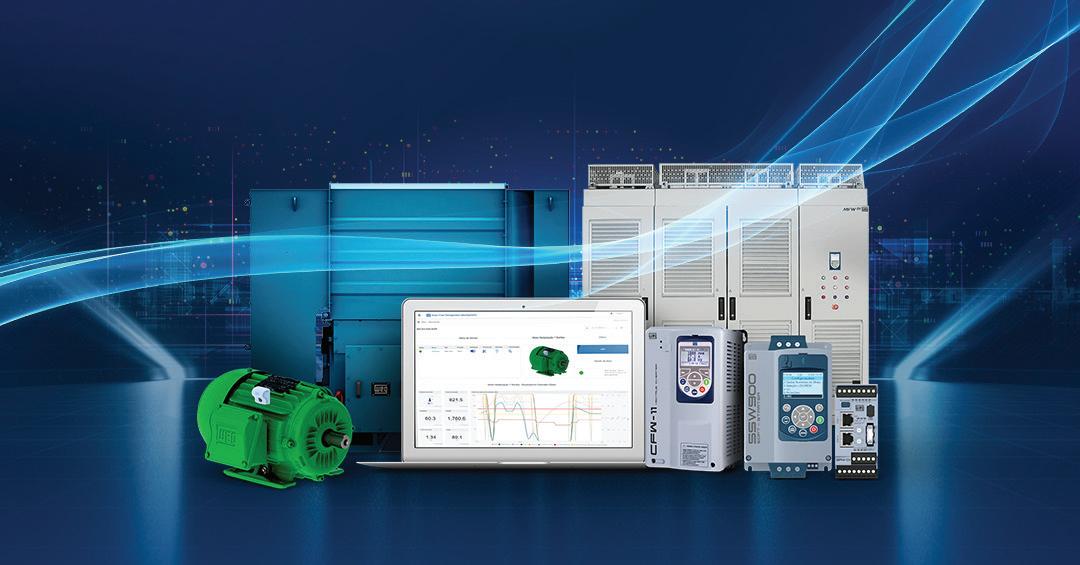



EBARA PUMPS RELEASES NEW GSO MODEL PROCESS PUMP
Ebara Pumps Australia has recently introduced its new range of ISO 2858/5199 end suction process pumps to the Australian market. This new design allows for superior mechanical seal operation and extended life and has a range of material and customisation options to suit specific applications.
The GSO range of semi-open impeller process pumps is available in 304, 316, 316L and duplex stainless steel wetted materials, and has been designed by Ebara (Japan) engineers using the latest computational fluid dynamics (CFD) software.
One of the benefits of this design is that it can produce a low seal chamber pressure thus enabling superior mechanical seal operation and extended life. Also, the unique reverse open type impeller minimises axial thrust but also creates higher efficiencies for a semi open impeller type design.
The Ebara GSO model is a true ISO2858/ISO5199 end suction pump and is manufactured at one of Ebara’s many owned and operated factories located throughout the world, which all operate under the strict Ebara Japanese QA standards and management policies.
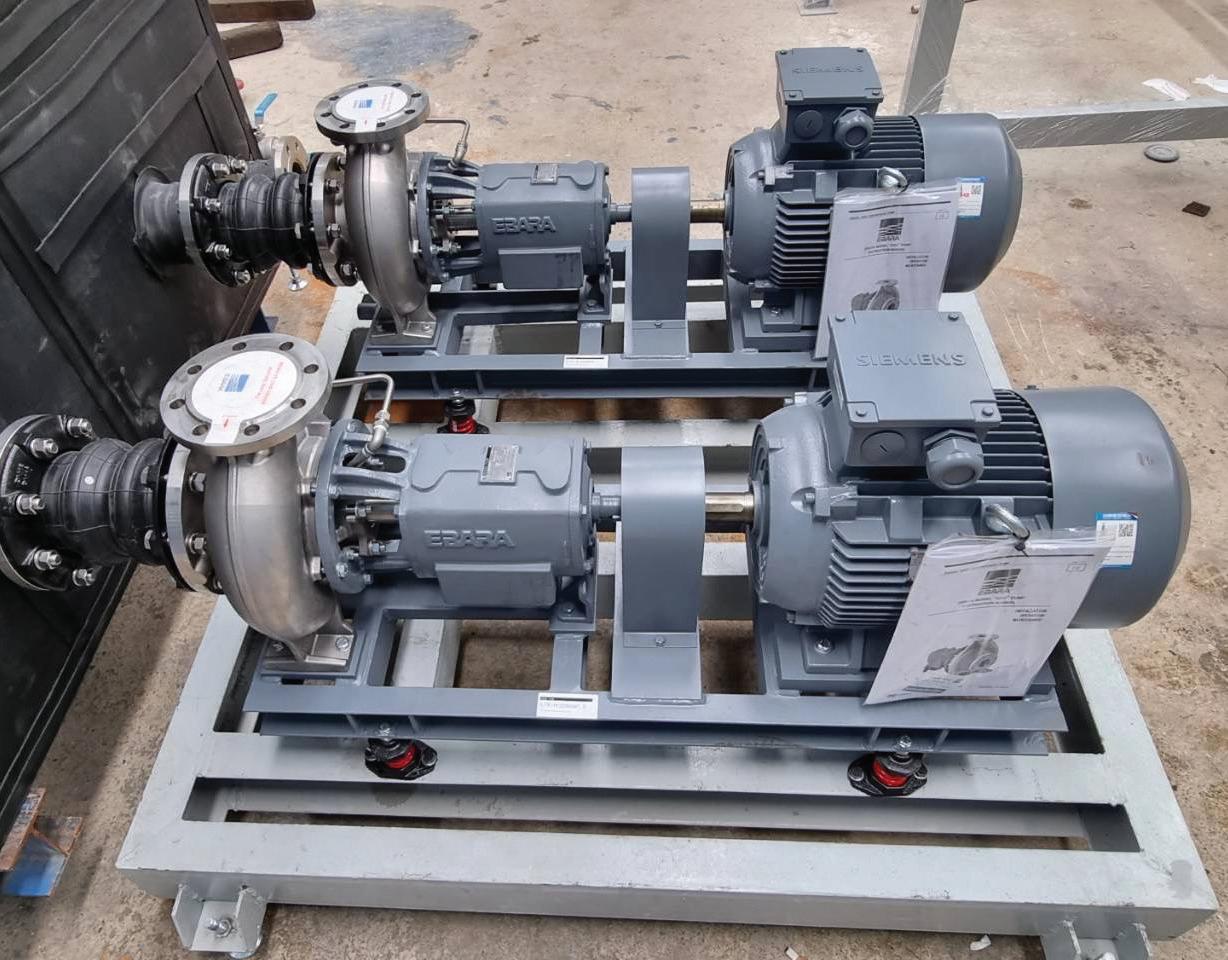
Other available options and features of the Ebara GSO include:
• 304,316,316L, duplex stainless steel wetted parts
• Reverse open impeller design as standard
• Grease or oil bath bearings
• Various single and double mechanical seal combinations
• Various mechanical seal piping plans
• PN 16 or ANSI flange drilling
• Sizes up to 200mm (discharge) and 500mm impeller (nominal)
The Ebara GSO is a true global pump and is sold throughout the world via the Ebara network of sales offices. Notable orders include for a water treatment plant in the middle east and various industrial applications in South East Asia.
About Ebara Corporation
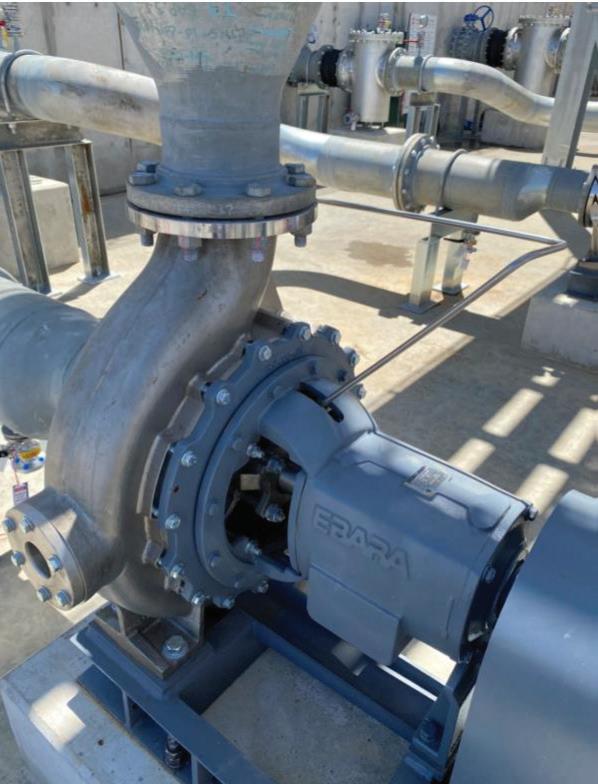
Ebara Corporation was founded in Japan in 1912 as a manufacturer of industrial pumps. Today, as a group it consists of more than 100 companies in six continents, with a workforce of more than 19,000 team members and with company-owned and Japanesemanaged factories that cover ten countries and four continents.
The huge scale of production and distribution is matched by a constant commitment to research, development and design of new products and the modern technologies for the manufacturing of them. Ebara products have gained a worldwide reputation for their technology and quality.
Ebara Corporation has developed businesses in the fields of fans and blowers, cooling towers, chillers, environmental plants and the precision machinery industry for computer chips.
20 pump industry | Winter 2023 | Issue 44 www.pumpindustry.com.au
PIA MEMBER NEWS | SPONSORED EDITORIAL
New hydraulic design - World leading performance
Combining over 100 years of experience with the latest computer aided design, EBARA has developed the new GSO series of pumps that offer world leading performance and efficiencies.
ISO2858/ISO5199 centrifugal process pumps
Pump dimensions to ISO2858
Mechanical design to ISO5199
Seal chamber to ISO3069
High efficiencies
Unique reverse open impeller design
Heavy duty shaft & bearing housing
Available in 304, 316, 316L & Duplex stainless steel
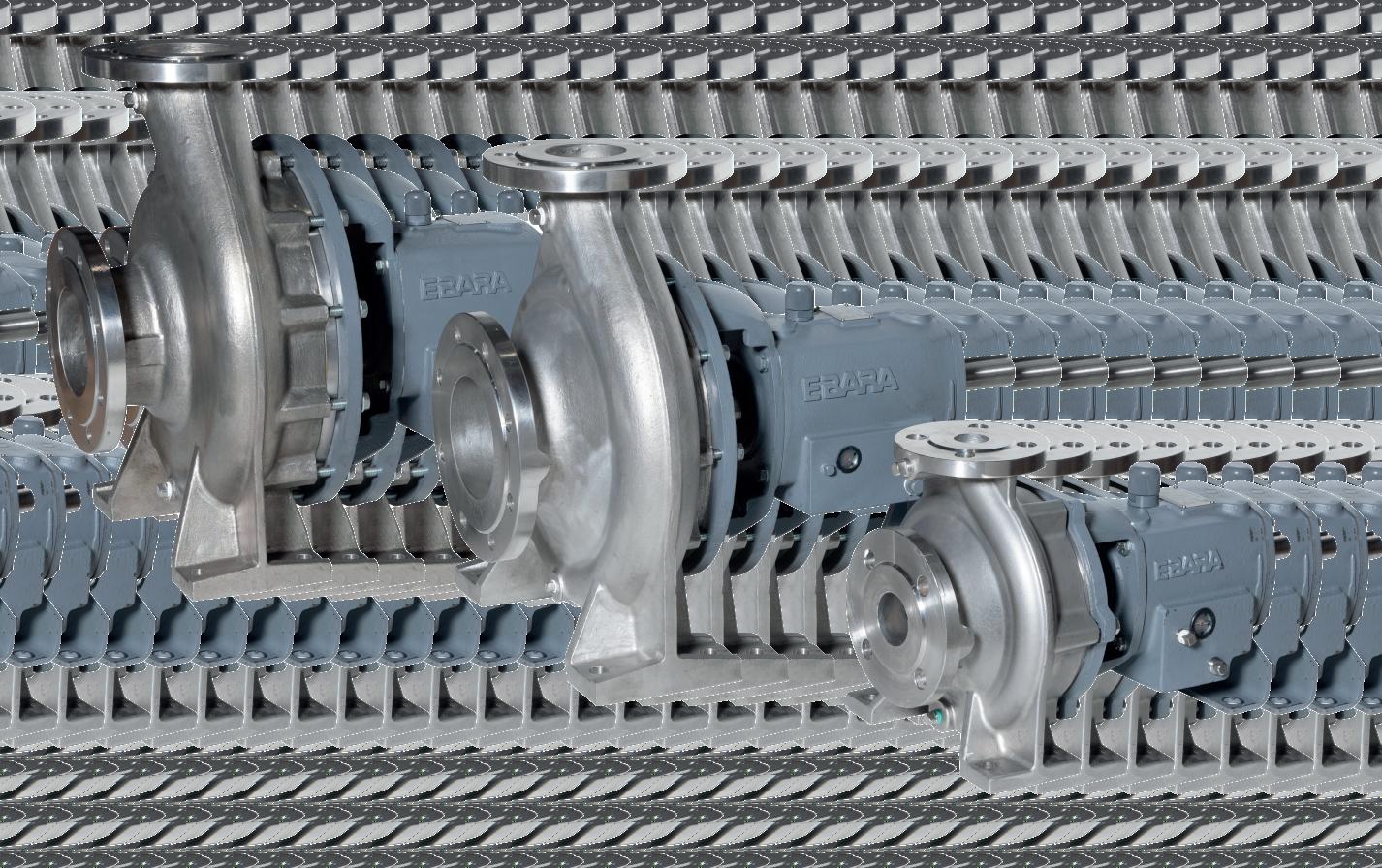
37 pump sizes from 50-32-125 to 250-200-500
Unique reverse open impeller design
Low axial thrust
Low seal chamber pressure
High efficiency
Less wear than with front open type
Able to handle light liquid slurries



Unique shaped rear shrouds developed by Ebara utilising Computational Fluid Dynamics.
21 www.pumpindustry.com.au pump industry | Winter 2023 | Issue 44 SPONSORED EDITORIAL | SECTION HEADING
going beyond expectations
Looking ahead,
Available now
www.ebara.com.au ACN 090 963 572 ABN 81 090 963 572 sales@ebara.com.au EBARA PUMPS AUSTRALIA PTY. LTD 7 Holloway Drive Bayswater, Vic. 3153 Ph: 03 9761 3033 2900 rpm 100 20 40 60 80 200 400 600 1000 150 8 10 15 20 30 40 60 80 100 Total Head (m) Capacity (m³/h) 1450 rpm 5 10 15 20 40 60 80 100 2 20 40 80 200 400 600 1000 300 100 60 10 Total Head (m) Capacity (m³/h)
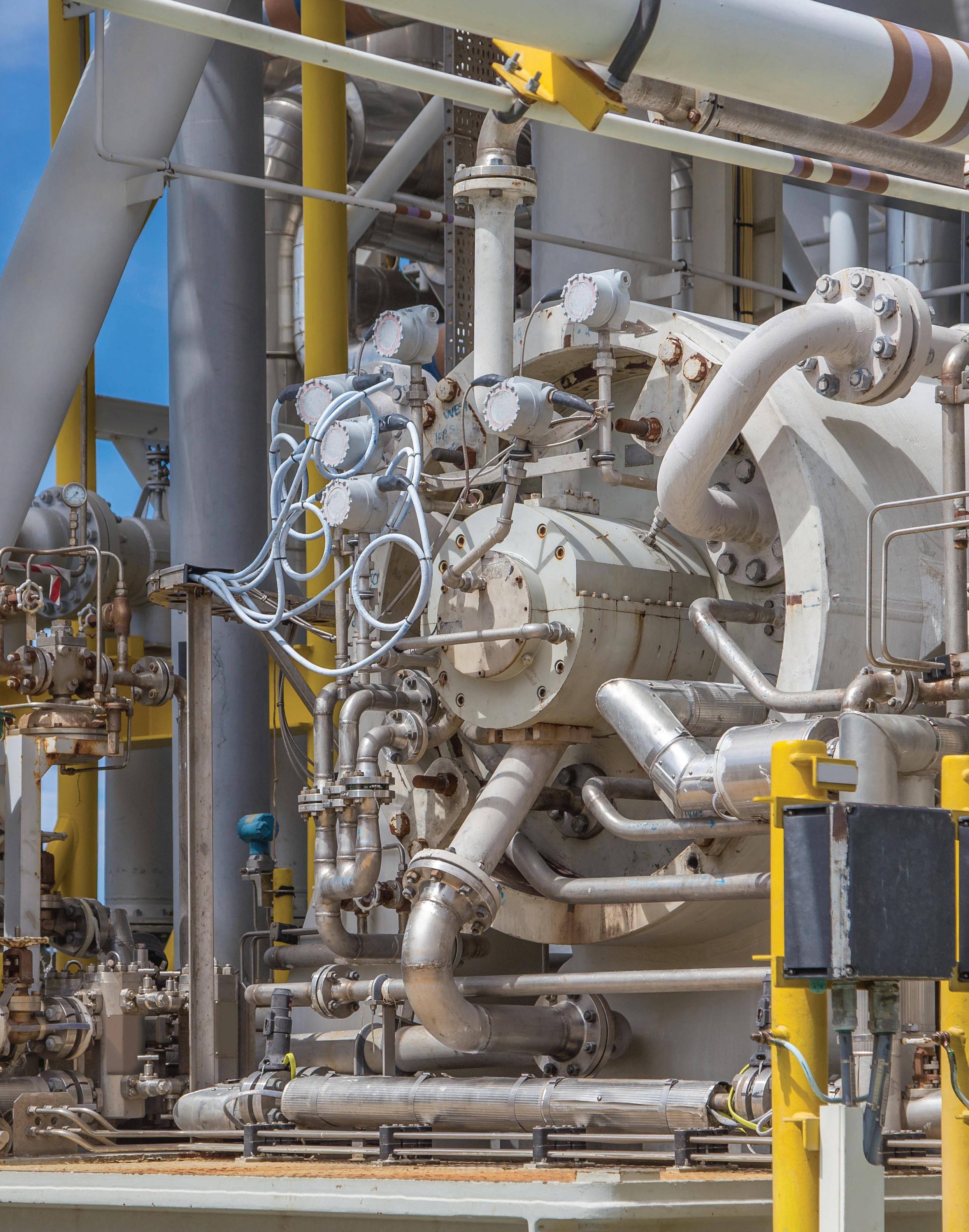
22 pump industry | Winter 2023 | Issue 44 www.pumpindustry.com.au MINING

CARBON CAPTURE IN THE NT
The Northern Territory Government is working to develop a carbon capture, utilisation and storage (CCUS) hub at Middle Arm. Here we discuss the project, how CCUS works and what pumps are used in the process.
As one of the world’s largest carbon emitters per capita, Australia faces the challenge of reducing greenhouse gas emissions while still relying on fossil fuels for its energy needs.
Carbon capture and storage (CCS) is an emissions reduction technology that could have the potential to help mitigate climate change by preventing greenhouse gases from contributing to global warming.
CCS is the process of capturing carbon dioxide (CO2) emissions and storing it deep underground to prevent its release into the atmosphere. Utilisation involves turning that carbon, which would otherwise be waste, into feedstock for another industry or purpose.
Pump technology plays a vital role throughout the CCUS process, and is utilised to facilitate the movement, compression and injection of CO2 during CCS activities.
As CCUS projects continue to develop, the pump industry will play a crucial role in ensuring the safe and efficient operation of CCUS systems.
Middle Arm Sustainable Development Precinct
The proposed CCUS hub at the Middle Arm Sustainable Development Precinct will be one of the largest facilities of its kind in the world.
Once carbon is captured and transported to the hub, it will either be stored or used. Storage at the precinct will entail carbon being sent via a pipeline to geological storage outside of Darwin.
There will also be opportunity for industries to utilise carbon captured at Middle Arm to produce other valuable products.
The Northern Territory Government is working in partnership with the CSIRO, industry and engineering companies to develop a business case to map a pathway for establishing CCUS at Middle Arm.
The State Government said the hub is intended to enable existing liquefied natural gas (LNG) production to expand while creating a lower carbon footprint, as well as establish new lowemission hydrocarbon and hydrogen based industries.
23 www.pumpindustry.com.au pump industry | Winter 2023 | Issue 44
MINING

Northern Territory Chief Minister, Natasha Fyles, said, “The Territory is rapidly emerging as a key player when it comes to the global supply chains, and new technologies needed for energy transition.
“We have always said the core component of the Middle Arm development is sustainability and will include renewable energy. We are creating new jobs for Territorians in existing and emerging sectors, including low-emissions energy, advanced manufacturing, and low-emissions minerals processing.
“The creation of a carbon capture and storage industry in the Territory will allow us to develop more projects as we work towards clean, green energy.”
With CCS gaining momentum, there is a greater need for reliable, energy-efficient pump technologies that can handle the unique challenges of CO2 transportation and injection.
Pumps and CCS
Due to the similarities between fossil fuel extraction and CCS, pumps used to inject natural gas liquids (NGL) into production fields (centrifugal pumps) and inject acid gas liquid back into the fields (high pressure pumps) can be applied to CCS activities.
Multistage pumps and hydraulic power recovery turbines can also be used in CCS processes at refineries, and petrochemical and chemical manufacturing plants.
CCS also encompasses a range of other pump-related equipment such as boilers, compressors, blowers and turbines.
In the capture phase, CO2 is separated and captured in a gas or exhaust stream. This can be achieved through precombustion, post-combustion, or oxyfuel methods. Pumps are employed to handle the movement of gases and facilitate the separation of CO2. Specifically, they help to maintain appropriate flow rates and pressures during processes such as absorption, stripping, and membrane separation. Both single and multistage pumps can be used, depending on the application.
Upon capture, the CO2 must be compressed to higher pressures for transportation and injection. Compression pumps, including centrifugal or reciprocating compressors, are often employed to increase the pressure of CO2. These pumps ensure that the CO2 is efficiently compressed for costeffective transportation via pipelines or other means.
The compressed CO2 is then transported from the capture site to the storage site. Pumps play an important role in this phase, providing the required pressure to overcome friction and transport the CO2 efficiently over long distances. Pump stations are placed strategically along the pipeline route to maintain pressure levels and regulate the flow of CO2
Once the CO2 reaches the storage site, pumps are used for the injection process. Injection pumps provide the pressure necessary to safely inject the CO2 deep underground into suitable geological formations.
The selection and design of pumps in CCS projects are critical to ensuring efficient and reliable operations. Factors such as flow rates, pressure requirements, temperature, and the properties of the CO2 stream must be considered when choosing the right technology. Additionally, pump systems in CCS need to be carefully designed and maintained to minimise leakage and ensure the safe and secure storage of the CO2 underground.
Unlocking the potential
Northern Territory Minister for Mining and Industry, Nicole Manison, said CCS is vital to achieving net zero emissions.
“The State Government is working with CSIRO, INPEX, Santos and other big industry players to establish a carbon capture and storage common-user hub at Middle Arm.
“We are making sure we are creating an industry that will be able to provide crucial energy security to Australia and the region, into the future,” Ms Manison said.
The Northern Territory’s existing LNG industry, export links with the Asia-Pacific region and high renewable electricity potential mean it is well positioned to create valuable CO2-derived products and support industry’s decarbonisation efforts.
A recent report by CSIRO highlights the opportunity for CO2 utilisation to support low-emission manufacturing in the Northern Territory, as part of the Northern Territory Low Emission Hub business case.
According to the report, the Northern Territory could turn waste carbon dioxide into commodity products by integrating CO2 utilisation technologies into local hub developments.
CSIRO Oil and Gas Researcher, Dr Andrew Ross, said, “The potential near and long-term role of carbon capture and utilisation within a Northern Territory Low Emission
24 pump industry | Winter 2023 | Issue 44 www.pumpindustry.com.au MINING


Hub is an important input to understanding the interaction between different industries in the context of a low emissions industrial ecosystem.”
There are opportunities to manufacture methanol, jet fuel, urea, methane and mineral carbonates in the Northern Territory using captured CO2
Urea is a compound with a high nitrogen content and is commonly used in fertilisers, although it is also used for resins and glue, fuel additive Adblue, medical and cosmetic products and fire extinguishers.
While Australia imports the vast majority of the urea it requires, the precinct offers the opportunity to make urea using CO2 waste from other industries.
Another example of carbon utilisation is cement manufacturers developing technologies to inject carbon into their manufacturing process. This improves product performance and offsets emissions.
Development of a hub with shared CCUS and hydrogen production infrastructure can support the deployment and scale-up of CO2 utilisation opportunities.
Limitations of CCS
The large-scale CO2 storage hub could support the development of low emissions industries, benefit manufacturing industries, and have the potential for a significant emissions management hub beyond the Northern Territory, including South-East Asia.
However, the CCS is not a substitute for clean energy sources such as wind, solar and pumped hydro. While CCS can only address emissions from specific sources, clean energy sources provide a long-term solution to reduce emissions across numerous sectors.
In addition, the CCS process is not foolproof. It carries the potential risks of leakage or accidental release, which can have a significant environmental impact.
Successfully mitigating climate change will require a reduction in reliance on fossil fuels and widespread adoption of clean energy sources. CCS should play a complementary role as Australia transitions away from gas and coal.
25 www.pumpindustry.com.au pump industry | Winter 2023 | Issue 44
MINING
Exploring BEETALOO’S FRACKING FRONTIER
Situated roughly 500km south-east of Darwin is the Beetaloo Sub-basin, an enormous shale gas reserve known for its vast energy potential and significant natural resources. Here we take a look at fracking in the Beetaloo and explore how pumps are used in this controversial process.
The role of gas in Australia’s energy transition continues to be the subject of ongoing debate. As the nation gradually increases its renewable capacity, many argue that new gas projects play a vital role in the energy mix. However, this line of argument has also been called into question, as Australia exports a significant amount of the gas it produces.
Gas projects involving hydraulic fracturing (fracking), the method of extracting gas from shale formations, face even more controversy.
In the Northern Territory, many have raised concerns about the impacts of fracking in the Beetaloo Sub-basin – a
significant natural gas reserve. The Territory Government, however, has cited its potential to help meet energy demands and boost the region’s jobs and economic growth.
In May 2023, the Northern Territory Government gave Beetaloo the green light to move into commercial production. Three companies –Tamboran Resources, Empire Energy and Santos – are currently exploring in the Beetaloo.
As the holder of the biggest tenement position across the site, Empire Energy welcomed the announcement.

Empire Energy Managing Director, Alex Underwood, said, “Building on the encouraging results of our exploration activity over the last four years, we look forward to submitting applications for all required approvals to enable us to move into gas production and the delivery of much-needed new gas supply to the Australian domestic market, and subsequently to increase LNG exports, already the NT’s largest source of foreign income and a significant contributor to Federal Government revenues.”
Empire Energy has conducted extensive seismic surveys and exploratory drilling programs in the
MINING
26
Beetaloo. The company has been evaluating the potential gas resources in the basin, assessing gas content and productivity to determine the viability of gas extraction.
In late 2021, Empire announced it had successfully drilled, cased, and suspended Carpentaria-2H (C-2H) – its first horizontal well located within its 100 per cent owned and operated EP187 tenement. Fracking activities in C-2H began in July 2022.
The role of pumps in fracking
There are two primary pumping and pressure applications involved in the upstream production process. The first application is the extraction of water and gas from the wells, while the second is the compression of the gas for transport via high-pressure pipelines.
Fracking involves injecting a fluid mixture into the wellbore to create fractures in the shale rock. Various types of pumps are used to generate the high pressure needed to push fracking fluid into the well, causing the rock to fracture and create pathways for the trapped gas or oil to flow. Pumps must be large and robust to be able to handle the demanding conditions of the process.
Progressive cavity pumping systems are often used to extract water from the wells. These systems utilise progressive cavity pumps, which are lowered into the well casing on steel tubing to a depth of around 800 to 1000 metres. The pumps are driven by a rotating steel shaft connected to the surface, either through a hydraulic power unit driven by
a gas-fired engine or electrically using a gas-fired microturbine combined with a variable frequency drive.
As the progressive cavity pump rotor spins, water is forced up inside the steel tubing. This extraction of water helps reduce pressure in the targeted shale formations, enabling the release of natural gas. The gas flows to the surface between the well casing and tubing due to the lowering of water levels and pressure.
Triplex or quintuplex pumps, a different type of positive displacement pump, are frequently used in fracking. These pumps are capable of generating the high pressures required for fracking activities.
Centrifugal pumps are often used in fracking for specific purposes, such as transferring or circulating fluids within the fracking system. They operate by using an impeller to create centrifugal force that pushes the fluid outward, generating pressure and flow. Centrifugal pumps are typically employed for water transfer, fluid circulation, or blending operations during the fracking process.
Following extraction, at the wellhead, the extracted gas and water are separated and sent through separate low-pressure gathering pipeline systems. The gas is then compressed to sales gas pressure for transportation via high-pressure pipelines. The water is directed to central water treatment facilities for further processing and treatment.
Pumps used in fracking are also closely monitored and controlled to maintain the desired pressure, flow rate, and fluid consistency. Advanced technologies and sensors are often employed to monitor pump performance, ensuring efficient and effective operations.
Frack programs are often designed to meet the unique geological and reservoir conditions of the region. Empire has tested a number of frack fluid mixes to understand which design will achieve the best production results.
One challenge with fracking is that materials pumped underground need to be slowly removed over a matter of weeks, in order to keep the perforations steady and stabilise pressure downhole. Fracking waste materials are transported to a dump on-site or into tanks, depending on cost and logistics. Once fracking materials (including sand abrasive liquids, acids and expanding gels) have been removed, companies are able to commence gas flow testing.
Advancing operations in the Beetaloo
Empire Energy’s C-2H well production test provided the company with an early production-type curve and a better understanding of gas composition in developing a full field development plan, including processing and gas handling facilities.
In May 2023, the company announced it had wound up its latest round of flowtesting at C-2H, pulling up a total of 323 terajoules over 127 days.

MINING 27
As well as monitoring the well’s flow rates, the company also used pump tests to garner important information, examining the benefits of soaking in Beetaloo and understanding the flow characteristics of the Velkerri B shale host.
Soaking refers to when injected fracturing fluid is left to sit in the wellbore and the formation for a certain period of time. During soaking, the fluid interacts with the rock formation, allowing it to penetrate deeper and initiate or enhance the creation of fractures. Pumps are usually shut off during this stage.
Following the completion of flow testing, Empire Energy shut-in C-2H and earmarked the well as a future gas producer.
In early March 2023, the company announced it had put its Carpentaria-H3 (C-3H) well through its paces by testing flow pressure for 27 days straight. It then began the shut-in processes for soaking after fracture simulation. This refers to a series of complex processes to increase the flow pressure of the well.
In late March, Empire announced it had lifted its average 30-day gas flow rate by more than 17 per cent in initial tests held at the Beetaloo Basin, citing the results as validation of its soaking strategy.
The company recently released revised estimates of its EP187 resource, which includes technical results from its 2022 drilling, fracture stimulation and production-testing campaign.
Empire’s management believes that results from its C-2H and C-3H wells demonstrate that it can cost-effectively deliver 3km of hydraulically-stimulated horizontal wells utilising Australia’s existing rig and frack spread fleet. The wells represent the intended design for future development of its Carpentaria project at EP187.
Concerns surrounding fracking
While government support has allowed Empire Energy to increase its portfolio of gas opportunities and move projects in Beetaloo forward, controversy still surrounds the development.
The risks associated with fracking include:
• Air pollution: fracking involves the release of volatile organic compounds and hazardous air pollutants, which can have detrimental effects on human health and contribute to climate change
• Risk to water resources: fracking requires large amounts of water mixed with chemicals that may be harmful and can potentially contaminate groundwater through leaks or improper disposal of wastewater
• Induced seismicity: fracking has triggered small to moderate earthquakes in some regions
• Greenhouse gas emissions: the extraction and burning of fossil fuels obtained through fracking contributes to emissions, exacerbating climate change
Fracking can also have social and economic impacts, such as increased truck traffic, noise pollution, disruptions to local communities and conflicts over land and finite water resources.
The Federal Government has played a major role in supporting the exploration and development of the Beetaloo, with the previous coalition government committing significant amounts of funding. This support has drawn condemnation from some communities, including traditional owners who fiercely oppose the development.
Empire Energy was awarded $21 million from the Federal Government under the Beetaloo Cooperative Drilling Program, sparking a federal court challenge by environmental activists, who argued that the decision to give Empire the money was unlawful because the federal resources minister at the time failed to properly consider the risks to global heating.
However, in October 2021 the company announced it had secured environmental approval from the Northern Territory Government, granting it permission to drill new wells in the basin.
Concerns around fracking led to an almost two-year moratorium on unconventional sale gas developments in the Territory, beginning in 2016. An independent Scientific Inquiry into Hydraulic Fracturing of Onshore Unconventional Reservoirs in the Northern Territory was also initiated.

MINING 28
Findings were handed down to the Territory Government in 2018. It announced it had accepted all of the recommendations and lifted the moratorium. One of the key recommendations was the Strategic Regional Environmental and Baseline Assessment (SREBA), which the government committed to finalising before any production licences were issued.
The three-year SREBA study found no new risks associated with the development of an onshore gas industry and in 2023 the Territory Government announced it had finalised all 135 recommendations of the inquiry, including a new regulatory framework for fracking. This set the stage for approval of gas production in the Beetaloo.
The Territory’s independent regulator has disputed the claim that the government met all of the recommendations of the inquiry before approving fracking.
Regardless of the Northern Territory Government’s decision, the harmful effects of fracking and fossil fuels remain an issue.
Empire is likely to begin construction on its Beetaloo pilot gas production facilities in early 2024.
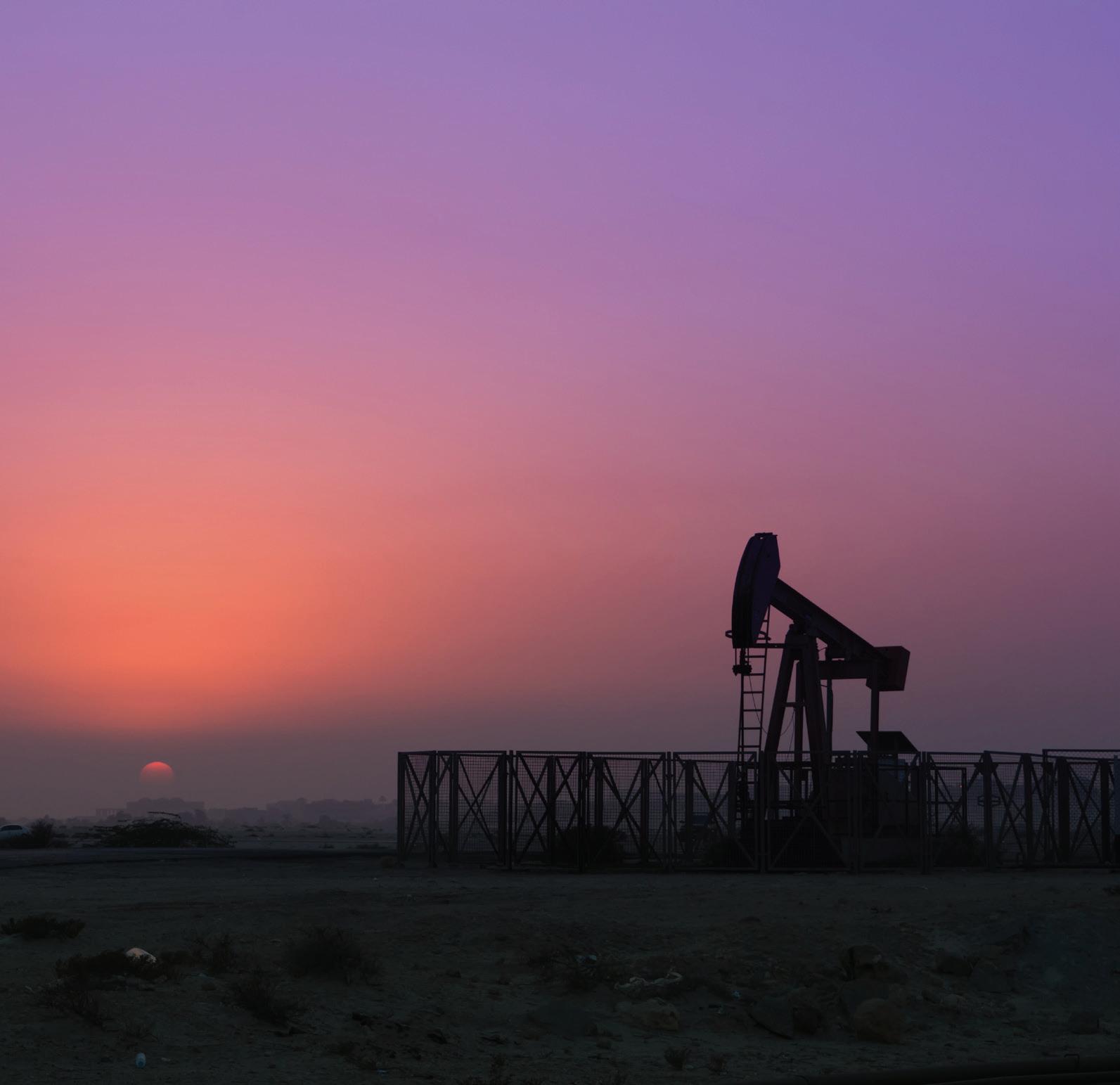
FOR HIGHER MOBILITY MINE DEWATERING UNIT

The SEEPEX Mine Dewatering Unit, used in both fixed and mobile installations, is engineered for efficient separating of oversized solids and conveying of mine water. The unit consists of a skid baseplate, tank, pipework and pump with drive and controls. The compact design enables easy transport, while the effortless maintenance reduces downtime and costs.
y Maintain in Place design: Quick and easy maintenance and no dismantling of pipework
y Lower operating costs
y Lightweight components
y Robust pumps for small spaces
y Equal wall stators increase pressure capability
SEEPEX Australia Pty. Ltd. T +61 2 43554500 info.au@seepex.com www.seepex.com
29 www.pumpindustry.com.au pump industry | Winter 2023 | Issue 44
MINING
 Katie Livingston Editor, Pump Industry Magazine
Katie Livingston Editor, Pump Industry Magazine

It can be challenging to strike the right balance when marketing to the pump industry, where the emphasis is on providing end-users with products and solutions that effectively and efficiently meet their needs. If you’re not familiar with business-to-business (B2B) marketing solutions, it can be difficult to get the best results.
The most successful businesses, particularly in B2B sectors, approach marketing with a multi-pronged strategy. This includes a combination of a great website, effective social media campaigns and a wellresearched, well-executed content marketing plan.
When organisations are choosing who to partner with to help them deliver their marketing strategy, there are marketing experts, and then there are industry marketing experts. In a B2B setting like the pump industry, you should be working with the latter.
30 www.pumpindustry.com.au
INDUSTRY MARKETING

CONTENT MARKETING 101 FOR THE PUMP INDUSTRY
What is content marketing?
Content marketing is a strategic marketing approach focused on creating and distributing valuable, relevant and consistent content. The goal is to attract and retain a clearly defined audience ‒ and ultimately drive action and sales.
Content can be produced in various forms including news articles, blogs, whitepapers, ebooks, newsletters, infographics and social media posts.
Chances are you know your industry better than most, but if creating content is not your main focus, you’re probably not doing it effectively. Pump Industry Magazine Editor, Katie Livingston, explains the unique content marketing challenges faced by companies in the pump industry, and how specialist content teams have an impact.
“The pump industry is unique, complex and includes a variety of different challenges, with high value placed on content that helps members of the industry solve the problems they deal with every day.
“It can be difficult for those working in the industry to find a marketing professional that can comprehend the intricacies of these challenges; and explain pump industry issues clearly without oversimplifying a situation.
“Pump end-users are dealing with complex challenges, and they need their problems solved yesterday. Here at Pump Industry Magazine we know marketing that successfully targets this audience, focuses on solving pain points and demystifying the hidden workings of complex machinery.”
Katie says it’s important to have an editorial team that understands the challenges of the end-user, who in the case of Pump Industry Magazine, is individuals working across a wide variety of verticals, including water and wastewater, oil and gas, chemicals, food and beverage and more.
“We know that when people read industry articles, they are looking to gain something – whether that be new knowledge, expert insight or solutions to certain problems. When a writer already knows who their audience is, and how to write for that audience, they have a much better chance of producing content that is meaningful to the reader,” Katie said.
What content is useful to potential customers?
A good content marketing piece of work solves a problem for potential customers. You know what your customers are asking. You know their pain points. Some of the best content your business can create will address these issues. Great articles are then read, saved, shared and ultimately draw customers to you when they are ready to buy.
Katie said there are many different types of articles that appeal to customers in the pump industry.
“Longer feature articles that explore technical challenges with pumps and pump systems, and explain in detail how to resolve problems and overcome these challenges, are particularly popular with our readers. Creating content like this can position advertisers as industry experts and thought leaders within the industry. In addition, project stories can emphasise a particular area of expertise for a business.”
31 www.pumpindustry.com.au pump industry | Winter 2023 | Issue 44
INDUSTRY MARKETING

Strategy is the key to success
Successful content marketing, and marketing in general, comes from having a clear strategy that is executed flawlessly. The biggest content marketing mistake businesses make is to release content with all guns blazing for a couple of weeks, then leave their customers listening to crickets for the next few months. Perhaps they hit them with another flurry of content a few months down the track, but they lack consistency or a defined strategy.
All companies benefit from having a clear content marketing plan in place, and those in the pump industry are no exception. This plan should include a commitment to release content relating to industry-specific events throughout the year, such as the impact that the Federal or State Budgets may have on customers or others in the industry.
The content marketing plan should be flexible enough to be able to respond to unexpected relevant events, such as the release of a new standard that impacts the industry, or the announcement of a funding grant. Working with content specialists within the industry makes it easier to lay out article plans for the year. Having dedicated writers who know the industry means this content can be produced quickly and while it is still relevant.
Businesses also need content that can be prepared ahead of time to keep customers informed and increase their own brand recognition. In the pump industry, these could be articles around new products that increase the efficiency of pumping systems, or allow manufacturers to create their products more effectively.
Leading businesses will also have some long-form content available – such as whitepapers or ebooks – with comprehensive analysis that help to stamp them as an authority in the market.
Be sure that web content suits the online world
Before great content actually makes an impact, it’s important for a business website to be in good shape. This includes being mobile responsive, since so many people view websites on their phones. It’s also good to produce content for search engine optimisation (SEO), which means making use of a range of keywords, optimising images for the web and successfully building relevant links.
Businesses in the pump industry should also be careful not to disregard social media in their marketing plan. Sticking with the goal of avoiding being obnoxious, there are still ways to interact with potential customers through social media without being too intrusive.
Facebook has a place in business to consumer (B2C) transactions, and to a lesser extent business to business (B2B) interactions. Given many decision-makers are on Facebook, business content can still reach these people and have an impact. The downside is that they are often not in business decision-making mode when using Facebook. Your best bet is to be sharing content of value that people appreciate reading. When they are at work and ready to make a purchase, your business has already made an impression on them.
LinkedIn is a great platform for businesses in the pump industry to foster B2B transactions and nurture relationships.
32 pump industry | Winter 2023 | Issue 44 www.pumpindustry.com.au
INDUSTRY MARKETING
Being a professional network by nature, LinkedIn is a convenient and appropriate way to keep in contact with other industry leaders.
There is often a spike in connections made after networking or industry events such as AIMEX, Irrigation Australia, IMARC and OzWater. Once these relationships are formed, the content-sharing nature of LinkedIn can broaden your reach in the industry.
What’s next for marketing in the pump industry?
The goal will always be to stay relevant to the intended customer base. This is often best achieved through targeted content marketing produced by journalists with industry knowledge as well as general writing experience.
Pure industry experts often lack writing skills to get their message across. Pure marketing experts don’t have the industry knowledge to produce quality content for the intended audience. Find someone in the middle who has both sets of skills.
Want a more in-depth understanding of content marketing?
Scan the QR code below to learn how we can help you achieve your marketing goals.

4 ways B2B marketing is different to consumer marketing
1. Different demographics
When marketers are targeting the consumer market, they often base their campaigns on traditional demographics like age, gender and income level. But B2B demographics are very different, and a scattergun approach simply won’t work and can waste a lot of resources. B2B marketing should be done through platforms where you can directly target these people. This could include meeting them directly at industry events, targeted campaigns through LinkedIn, where you can segment on appropriate demographics, sending newsletters to existing clients or lists you build yourself, advertising in industry journals that the right people actually read, and custom-lead generation campaigns.
2. Long lead times
Many consumer purchases are made once and straight away, possibly in a physical shop or increasingly online. But many B2B deals involve a tender process, or protracted negotiations for high value deals – it’s not a click and forget scenario. As a result, it’s important to set the pace of your marketing to match the length of your sales cycle. This means that it’s ok to drive traffic to your site if that’s what you want to do, but if they’re not ready to buy that day, you should still have options for them to engage with you, such as a newsletter to sign up for or an eBook download or webinar registration for which they provide their details.
3. Dealing with multiple decision makers
When a consumer makes a purchase, they decide and that’s it. In B2B, there’s often a whole chain of people who are involved in some way in the decision making process. If you are dealing with a large organisation, there may be more hands-on employees that use the product and recommend it, senior management that have ultimate sign off, or even external stakeholders like engineering consultants who make recommendations. Good marketing needs to reach all of these people with different variations of your message that are adapted but also consistent.
4. Personal relationships

In B2B, it’s often necessary to have ongoing, long-term relationships with the individuals at the companies you sell to. This means that consistency and reputation are key. This matters in all marketing, but in B2B it’s as much about your personal integrity and reputation as anything else. The best way to deliver on this is by living these values. But the perception can be further enhanced with the right marketing and communications. In B2B there’s often great scope to build up the profile of your key staff as experts or thought leaders. The more they get quoted on a topic, speak at a conference, or be seen in trade media or on social media, the more that trust will be reinforced.
33 www.pumpindustry.com.au pump industry | Winter 2023 | Issue 44
INDUSTRY MARKETING
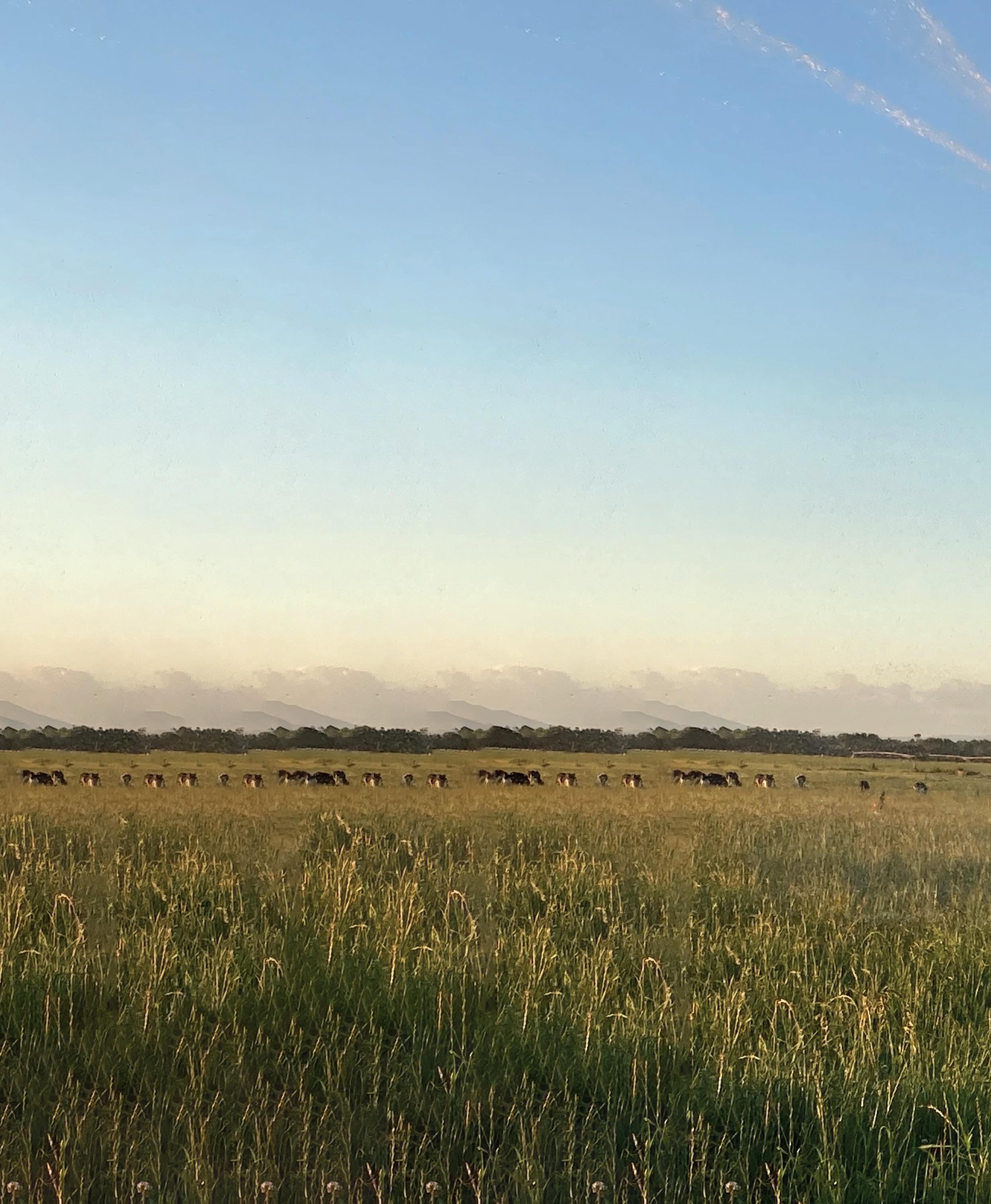
IRRIGATION OVERHAUL: HOW PUMPS HELPED A DAIRY FARM’S RENEWABLE ENERGY TRANSITION
Sandra Jefford and Wilco Droppert own and operate Wilandra Farms, an organic dairy farm in the Gippsland region of Victoria. Despite the farm’s success, energy costs were high and irrigating the farm was a costly and time-consuming process, with irrigation and dairy operations using about 500,000kWh of energy per year. In an effort to reduce both the cost of irrigation and their carbon footprint, the couple embarked on a mission to generate their own power and upgrade their pumping system.
34 pump industry | Winter 2023 | Issue 44 www.pumpindustry.com.au
IRRIGATION

35 www.pumpindustry.com.au pump industry | Winter 2023 | Issue 44 IRRIGATION
Sandra and Wilco moved to the Gippsland area in 2011 and began farming organically in 2016. Located at Clydebank, Wilandra Farms is a certified producer of milk, silage and hay and the property houses 380 certified organic dairy milk cows year-round.
With the success of the farm have come bumps in the road. The couple realised that the farm’s energy costs were too high, particularly in relation to irrigation – which was accounting for 70 per cent of the power used on the farm. They had been using a diesel pump to pump water from the dam to pivots, which was not only expensive, but bad for emissions and a huge drain on manual labour.
Sandra and Wilco opted to install two 37kW Caprari electric pumps to replace the diesel pump that was used to pump water from the dam to the pivots. This had many benefits for the farm – the pumps can be operated remotely via phone or computer, saving the pairmany hours each week from having to drive between pumps and pivots. The variable speed pumps also improve energy efficiency by ensuring that the irrigation system does not run when it doesn’t need to. For example, in 2022–23, the area was very dry from mid-December to late March – so the irrigation system needed a lot of grid power. The system was able to adapt easily to the change in conditions, resulting in very little peak price power.
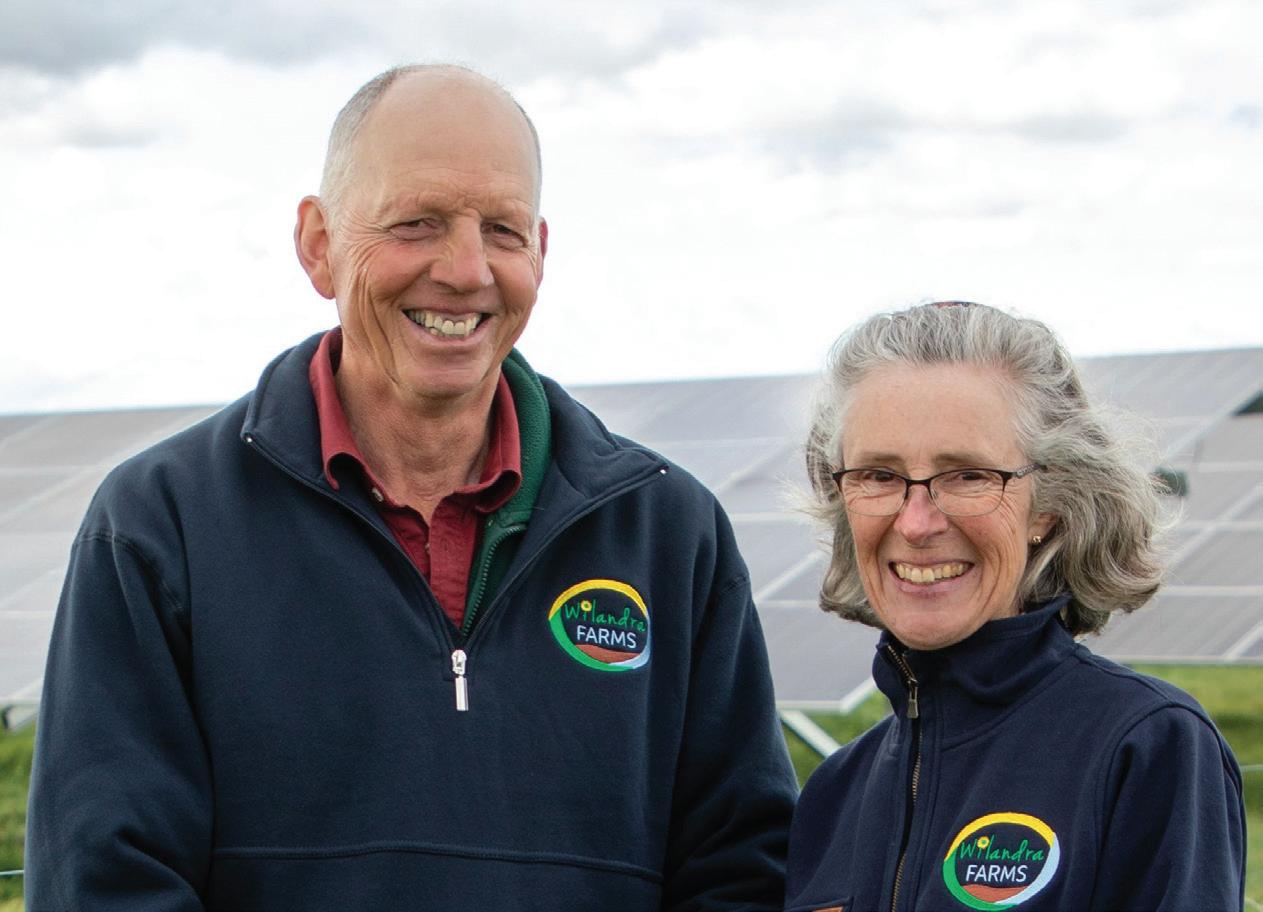
The farm’s soaring energy bills led the couple to pursue an energy audit. While the purpose of the audit was initially to lower costs, Sandra and Wilco realised that there were other benefits to upgrading and updating their irrigation equipment. The energy audit opened their eyes to the potential benefits of renewable energy – which could also save the couple hours of work every day.
“Our energy project started because of the big energy bills, particularly for irrigation. And it was after we'd had the energy audit done, we then started to look at emissions related to energy and then that set us on the track of looking at emissions further. It was really the energy bills that started the whole project,” Sandra said.
Improving pump efficiency
The energy audit revealed multiple deficiencies in the farm’s current equipment and areas for potential improvement. Sandra and Wilco pumped all their irrigation water from bores and the Avon River, traveling through lengthy pipelines. The audit uncovered two key pieces of equipment that would have far greater capacity if replaced – the existing bore pump’s motor was too big, and a 500m pipeline was the wrong diameter. These two improvements alone are estimated to have reduced power use by about 37 per cent at the pumping site.
The couple were also using a diesel-powered pump to pump water from the dam to pivots. Because the pumps and pivots were not automated, the couple were frequently having to drive between them – costing them valuable hours every week. The manual diesel pump was constantly working, not able to adapt to changing conditions, which meant that emissions were also much greater than necessary.
“There's lots of benefits. We are saving at least 15 hours a week, maybe 20 hours a week in busy irrigation times because of the automation, because we don't have to drive to the pumps and the pivots anymore. We can stop and start things from a laptop.
“And we’re seeing big energy savings. January and February were extremely dry, so we pumped a lot of water. Even so, our cost of energy, the irrigation was only six cents per kilowatt hour. And so another advantage is with all the talk of the price of electricity increasing, we're quite nicely protected against that now because we don't need that much grid power,” Sandra said.
The couple also replaced two old, oil ring vacuum pumps with a lobe vacuum pump, resulting in less power demand and a far cleaner vacuum pump with no need for oil changes.
Investing in renewables
To lower energy costs whilst also investing in more sustainable solutions, the couple worked with Alternate Energy Innovations (AEI) in Morwell to develop a Renewable Energy Action Plan. They received funding through the Victorian Government’s Agriculture Energy Investment Plan to help with costs. So far, renewable infrastructure updates include the installation of 200kW of solar energy and 56kWH of batteries, with four 5kW wind turbines also in transit to the farm for installation – which has meant huge savings on the cost of electricity.
“We have dropped the price of power that we're using for irrigation down from 27 cents per kilowatt hour down to six cents per kilowatt hour this year. We've still got our equipment finance loan to pay off, but we've already been paying that off now for about two years, so we've only got five years. Then it's paid off, and we've got free energy generation. In terms of the total energy costs for irrigation, depending on the year and how much water we're pumping, we were spending between $80,000 and $100,000 on energy costs for irrigation,” Sandra said.
The investment in renewable energy enabled another big change – connecting the bore pump to solar energy. The farm houses solar panels facing north, east and west to maximise the amount of energy they can produce. Solar powers the pumps, and with the installation of variable speed pumps, energy efficiency has further improved by ensuring that the irrigation system doesn’t run when it doesn’t need to.
“With the bore, it's connected to solar power. Once we've got a low level of solar power early in the morning, that bore starts slowly dumping water in the dam. We are able to use a low level of farm generated power. The solar power is so successful, in future we will look at putting in more solar power because with it being so dry this past summer, we were using a lot of off-peak grid power, and in the future we'll try and replace a lot of that with farm generated power,” Sandra said.
36 pump industry | Winter 2023 | Issue 44 www.pumpindustry.com.au
IRRIGATION
Future bright for solar-powered irrigation
With many positive changes implemented, Sandra and Wilco are keen to continue with their renewable upgrades. One challenge the couple faced was with the installation of additional wind turbines. The couple expect to add two 15kW turbines to their existing stock of four – but due to a technical problem with the manufacturer in the UK, they are still waiting.
“We've got four five kilowatt turbines here as a temporary measure, and eventually we expect we'll have two 15kW turbines, because there was a technical problem with the manufacturer in the UK. And then there's been a problem getting inverters to be compatible with the turbines. And I think this is just because turbines at this sort of scale are still very unusual and the inverter manufacturers are not putting the effort into making the inverters to match the wind turbines,” Sandra said.
The electricity grid posed another challenge for Wilandra. There is no smart grid at the farm, so electricity generated at the farm goes into the grid, which they sell to for six cents, but they then have to buy it back from the grid for 36 cents. The couple said the grid needs a system that allows them to allocate the excess power elsewhere, rather than across a range of separate meters.

The couple also had the intention of installing a microgrid. Microgrids provide energy generation and storage at a local level, which would have enabled the couple to generate, store and sell even more renewable energy. However, strict regulations around microgrid installation meant that the couple had to alter their generation and storage plans.
“We had hoped to run a controlled microgrid on the farm, but the regulations are such that that's just not possible at the moment. But if farms were able to use controlled microgrids, they could make much better use of the renewable energy that they're generating. It becomes more cost effective. And we could hopefully see more farmers installing renewable energy on their farms, but we need a change in regulation,” Sandra said.
Despite these challenges, Sandra and Wilco are optimistic about further renewable upgrades to the farm – particularly the installation of more solar panels.
“Like a lot of other farmers, we've got land that isn't the right sort of size and shape to put a pivot on. We've got a project just getting started to put in fixed sprinkler irrigation using surplus solar power at a particular bore site where we've got 50kW of power. That's underway, and in future we'll have another look at how much solar power we need, and we'll probably look at putting another pump at the dam, so that each center pivot has its own pump that's pumping out of the dam to a pivot because that'll make the automation easier. At the moment, we've got three pivots and they share two pumps.
“So there’s plenty to do - we just need a good strong milk price to enable us to keep going with all these improvements,” Sandra said.
The couple recommend solar energy installation for all irrigators, saying that the cost savings, coupled with the huge environmental impacts, are hard to ignore.
“I think particularly for any irrigators, if you are using grid power, it's really worth having a look at installing solar energy. Particularly if you've got a dam, if you've got the ability to pump into a dam and then pump out, you can get some massive benefits with solar power,” Sandra said.
To encourage other irrigators to move toward renewable solutions,the couple hosted a knowledge-sharing event in February 2023, titled “Smart Farm Power – Opportunities in an uncertain carbon future”. Participants attended presentations and then visited the farm to view the automated irrigation and renewable energy system, and other features of the Wilandra Farms regenerative farming system.
Sandra said she felt it was important for the dairy industry to unite on a progressive path.
“I think farms can play a huge role in reducing emissions, and a collaborative approach using microgrids could even reduce the need for transition lines – that’s our hope for the future and we’re excited to share the results of our project to inspire others,” Sandra said.
37 www.pumpindustry.com.au pump industry | Winter 2023 | Issue 44
IRRIGATION Wilandra Farm: Year Comparison Power Usage Breakdown 70000 60000 50000 40000 30000 20000 10000 Jan 21 Feb 21 Mar 21 Apr 21 Solar Used Grid: On Peak Grid: O� Peak Total Solar Generated Jan 22 Feb 22 Mar 22 Dec-22 Jan-22 Feb-22 Apr 22 0 P o w e r U s a g e ( k w h
Solar
Output Projected to previous
Graphic credit: Steve Soutar, AEI

The pump industry relies on expertise from a large and varied range of specialists, from experts in particular pump types to those with an intimate understanding of pump reliability; and from researchers who delve into the particulars of pump curves to experts in pump efficiency. To draw upon the wealth of expert knowledge the Australian pump industry has to offer, Pump Industry has established a panel of experts to answer all your pumping questions.
In this edition of Ask an Expert, we will continue looking at progressive cavity (PC) pumps and how they can be utilised in the mining industry. PC pump experts are often asked if these pumps are suitable for the mining industry. In fact, PC pumps are very common on mine sites throughout Australia. For these pumps, this particular market sector would be on a par with water/wastewater as one of the most popular in Australia. Listing the various applications in detail would take up this entire issue of the magazine, so instead, below is a summary of the typical applications and key benefits of this pump design.
PC pumps are commonly used in the following mine types:
• Bauxite (also refined alumina)
• Coal
• Copper
• Gold
• Iron Ore
• Mineral Sands
• Nickel
• Shale Oil
• Tin
• Uranium
• Vanadium
• Zinc
PC pumps are also used by countless suppliers of mining equipment and chemicals for:
• Decanters and centrifuges
• Tunnel drilling equipment
• Flocculants
• Chemical dosing
• Liquid explosives

38 pump industry | Winter 2023 | Issue 44 www.pumpindustry.com.au ASK AN EXPERT
An example of an easily maneuverable mine dewatering unit.
What are the benefits of PC pumps?
The properties of PC pumps that benefit the mining sector are:
• Self-priming
• Minimal pulsation
• Valve-less operation and flow control
• Reversible for back-flushing
• Flow proportional to speed
• No day to day maintenance required
• Versatile: can be installed horizontally or vertically and in virtually any position
• Minimal flow rate variation even with changing pressures
• Handle multiphase products (liquid and gas) Common applications for PC pumps in mining transfer of mineral slurries
• Void back-filling applications
• Dosing of explosives
• Thickener underflow applications
• Centrifuge filling
• Chemical dosing
• Water treatment


• Cake transfer
• Leachate treatment
• Gland water supply
• Sludge feed to dewatering machines
Typical transfer liquids include polymers, sludge, slurries, grout, various chemicals and clean and dirty water. Mine dewatering applications for PC pumps
This is one of the most common areas where progressive cavity pumps can be seen, usually installed on a transportable skid with collection tanks for incoming water, and usually incorporating some form of solids separation to partially clean the muddy, high sediment mine water. The range of progressive cavity pumps used for these applications is long due to the pressure generation required to pump from several hundred meters underground to the surface. There are now a number of companies that specialize in this application area, and occasionally new designs are developed that can provide significant benefits to users of this product range. Keeping abreast of these developments can certainly pay significant dividends for mine operators. More detailed information on specific design developments can be requested using the contact details at the end of this article.
Peter Vila, Managing Director of SEEPEX Australia, is a progressive cavity pump expert. He has been involved with pumps for over 40 years. Peter spent the first five years repairing pumps and the following 35 years in technical sales, 20 of which have been with SEEPEX progressive cavity pumps.
For more information on progressive cavity pumps, please contact SEEPEX Australia on (02) 4355 4500 or at info.au@seepex.com
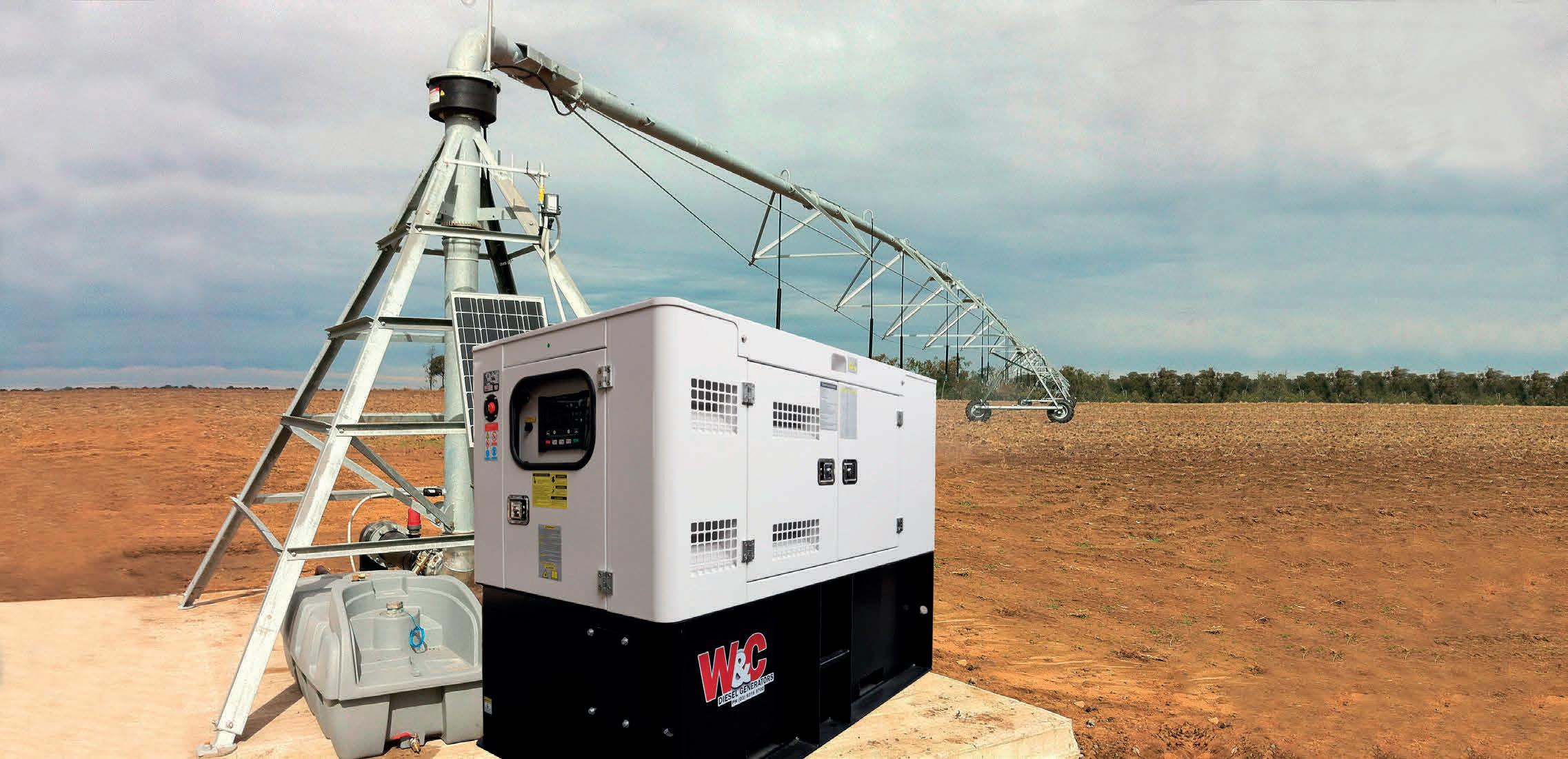







39 www.pumpindustry.com.au pump industry | Winter 2023 | Issue 44
AUSTRALIA’S TRUSTED DIESEL POWER AUSTRALIA’S TRUSTED DIESEL POWER Adelaide | Brisbane | Melbourne | Perth | Sydney | Townsville FOR YOUR PUMPING & IRRIGATION NEEDS Australian owned and operated since 1926. ▶ Diesel engines up to 800hp ▶ Diesel generators up to 860 kVA ▶ Diesel generators for prime, standby, sub pumps & centre pivot power sales@wellcross.com.au wellcross.com.au 1300 656 276 Scan Me! ASK AN EXPERT
PUMP SCHOOL

What are the solutions to pump cavitation?
When the pressure of flowing liquids drops to, or below, the liquid’s vapour pressure, the liquid boils and vapour cavities (bubbles) form locally inside the liquid. If the pressure within the flow path subsequently increases above the vapour pressure, the vapour cavities implode, releasing energy. The formation and sudden collapse of these bubbles is called cavitation.
What can be done?
The obvious answer is to ensure proper pump selection at the initial stage. Many users would agree that most pump vendors are sufficiently competent in giving customers what was asked for in the specifications. It is also imperative that the issue of NPSHA vs NPSHR is properly understood and considered by both user and supplier.
The solutions to existing cavitation conditions can be determined by considering both NPSHA (the system) and NPSHR (the pump). On the system side, the NPSHA can be increased by one or more of the following:
• Increase the static liquid level above the pump or reduce the suction lift. This can be done in the case of a flooded suction by raising the liquid level in the suction tank, raising the suction tank to a higher level, or lowering the pump. In the suction lift situation, the liquid level in the sump or suction tank can be raised or the pump can be lowered – for example, mounting the pump off the sump side or building a dry sump beside the existing sump.
• Reduce the friction losses by increasing pipe sizes and reducing the length of pipe runs and the number of fittings, e.g. tees, bends, valves. Selection of fittings with lower friction loss, such as long radius elbows and full flow ball valves, should also be considered. In particular, resist the use of suction strainers that can clog.
• Reduce the vapour pressure by reducing the temperature of the product. This can be done by reducing the operational temperature of the process (if feasible) or cooling the temperature in the suction line – for example, cooling annulus on the suction pipework. It must be noted the reduction of vapour pressure by reducing the temperature is rarely possible.
The remedies detailed below can be applied to the pump (NPSHR):
• Reduce the flow rate by throttling on the pump discharge. This will generally reduce NPSHR (always check the pump curve) and increase NPSHA (due to reduced friction losses). Care must be taken to ensure that the flow rate is not reduced below the minimum flow rate recommended by the manufacturer.
• Reduce the pump speed as this reduces NPSHR. This will require the user to accept reduced pump performance.
• Reduce the pump speed and install a larger diameter impeller. This will have a two-fold effect as lower speed means lower NPSHR and in many cases the larger impeller diameter has lower NPSHR characteristics.
• Install a different pump. This would normally mean installation of a larger pump as they generally have a better NPSHR value for the same flow rate. The selection of a larger pump is sometimes required with speed reduction.
• Change the impeller material to one that is more resistant to erosion – for example, from cast iron to stainless steel. This does not eliminate cavitation but will reduce the impact of cavitation.
With a vast array of pumping designs and solutions available, ensuring you have the right pump for the right application involves a thorough set of considerations. Moreover, proper pump selection at the initial stage is essential in preventing cavitation. Consider consulting your pump supplier to discuss your pumping requirements.

Cavitation damage to an impeller with segments chipped away.
40 SECTION HEADING pump industry | Winter 2023 | Issue 44 www.pumpindustry.com.au
Article courtesy of Kelair Pumps Australia “When Pump Knowledge Matters” Phone 1300 789 466, or visit www.kelairpumps.com.au.















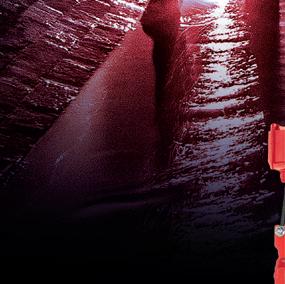






























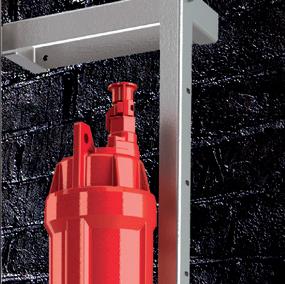






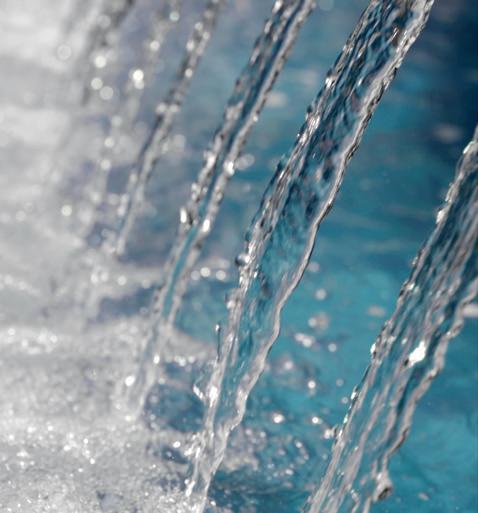

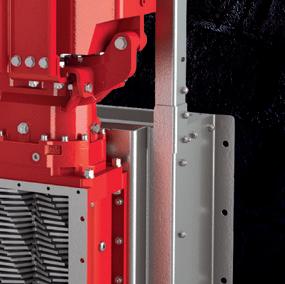









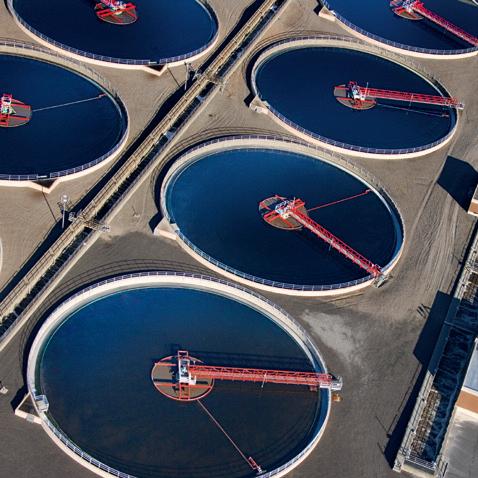





















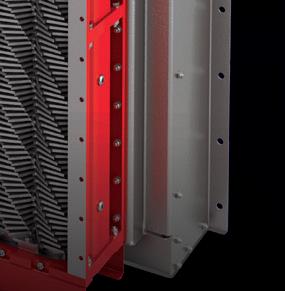


ENGINEERING FOR THE FUTURE




ENGINEERING FOR THE FUTURE




In everything we do, we never lose sight of what is more important to our customers: to work economically with a technology that is modern, innovative and reliable.
In everything we do, we never lose sight of what is more important to our customers: to work economically with a technology that is modern, innovative and reliable.
As the inventor of the elastomer-coated rotary lobe pump and innovation driver in the field of pumping, grinding and disintegration technology, Vogelsang has been one of the world’s leading mechanical engineering companies for decades. With progressive concepts and sophisticated technology, such as the RotaCut macerator or the wastewater twinshaft grinder XRipper, we work daily on efficient solutions for the individual applications of our customers.
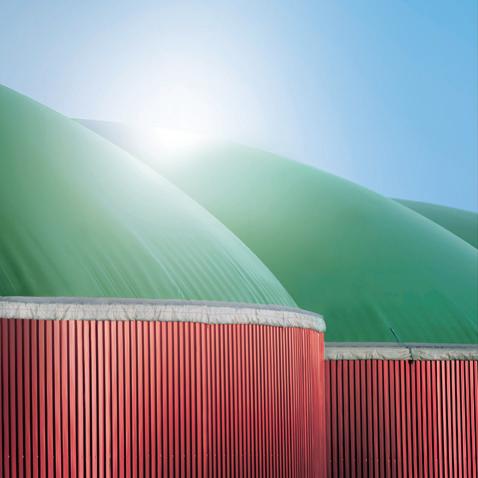















As the inventor of the elastomer-coated rotary lobe pump and innovation driver in the field of pumping, grinding and disintegration technology, Vogelsang has been one of the world’s leading mechanical engineering companies for decades. With progressive concepts and sophisticated technology, such as the RotaCut macerator or the wastewater twinshaft grinder XRipper, we work daily on efficient solutions for the individual applications of our customers.
We use our extensive know-how, the continuous further development of our technical solutions and our many years of experience in the field of environmental technology to support our customers as a competent partner. Among other things, with powerful and service-friendly technology. You can rely on competent and personal advice and reliable service.
We use our extensive know-how, the continuous further development of our technical solutions and our many years of experience in the field of environmental technology to support our customers as a competent partner. Among other things, with powerful and service-friendly technology. You can rely on competent and personal advice and reliable service.
VOGELSANG – LEADING IN TECHNOLOGY
VOGELSANG – LEADING
IN TECHNOLOGY
Unit 2/7 Dunn Road | Smeaton Grange NSW 2567 | Australia
Unit 2/7 Dunn Road | Smeaton Grange NSW 2567 | Australia
Phone: +61 2 4647 8511 | E-mail: sales.au@vogelsang.info vogelsang.info
Phone: +61 2 4647 8511 | E-mail: sales.au@vogelsang.info vogelsang.info




























GOING ELECTRIC : THE OPPORTUNITY FOR HEAT PUMPS IN
INDUSTRY


42 MANUFACTURING
Decarbonisation of industrial heat through electrification is key to not only reducing energy costs, but also tackling climate change. With geopolitical instability and increasing gas prices due to the Russia-Ukraine War, there is even more urgency to move away from fossil fuels. A recent report from the World Business Council for Sustainable Development (WBCSD) has highlighted the use of heat pumps for the electrification of heat as an opportunity to mitigate exposure to volatile natural gas prices, as well as reduce greenhouse gas emissions.
According to the WBCSD, heat from industrial processes accounts for 29 per cent of global energy demand and 15 per cent of all greenhouse gas emissions. This makes decarbonising industrial heat an area of opportunity for reaching net zero carbon emission goals.
Heat pumps are a great starting point for decarbonisation activities as they are easily scalable and have greater efficiency – particularly in light industry where there are typically lower temperature heating requirements. They are the only heating technology with potential thermal efficiencies above 100 per cent, meaning they can significantly reduce energy use, operational costs and emissions – and provide circular solutions so that one company’s waste heat can support another company’s heat needs. Commercially available heat pumps, which are currently limited to heat supply of up to 200°C and therefore primarily used within light industry, could supply 37 per cent of the current industrial heat demand.
“The electrification of heat is critical to decarbonise industrial manufacturing operations: heat pumps are one of the few commercially available and commercially viable solutions that can be implemented at scale this decade.”
- Mariana Heinrich, Director, Energy, WBCSD
However, despite their potential, the deployment of heat pumps has previously been limited due to technology barriers, insubstantial policy incentives and challenging energy market conditions.
WBCS’s report, Industrial Heat Pumps: it’s time to go electric1, highlights the developments and trends creating a compelling business case for heat pumps. It also provides guidance on selecting markets ready for heat pump deployment and key actions to help companies scale up industrial heat pump installations profitably – from combining heating and cooling to leveraging innovative financing mechanisms.
“Even prior to recent gas price inflation, clear market trends were making the business case to employ heat pumps in industrial heating applications ever clearer. Innovation in technology is making heat pumps capable of achieving higher temperature and, therefore, applicable to a wider range of industries.
1. https://www.wbcsd.org/contentwbc/download/14846/211001/1
2. https://iea-industry.org/app/uploads/annex-xiii-part-b.pdf
3. https://energy.ec.europa.eu/topics/energy-efficiency/heat-pumps_en
Innovation in applications is also creating unique business opportunities, through coupling of heat and cooling loads internally and externally –connecting to other businesses as well as district heating systems.”
- Marcel Cremers, Principal Consultant, DNV
The size of the opportunity
In 2019, globally, industry consumed around 23,700TWh of energy for heating applications, compared to the annual electricity consumption – including heat generation –which was around 25,000TWh. And with industrial heat demand predicted to continue rising in the coming decades, electrification using low or zero carbon power presents an opportunity for decarbonisation and helping to reach net zero emissions goals.
The report states that in light industry where heating requirements are moderate, electricity from electric heaters and heat pumps will satisfy 40 per cent of heat demand by 2023 and 65 per cent by 2050, in comparison to other clean fuel sources such as hydrogen (20 per cent) and bioenergy (15 per cent) in 2050.
In particular, heat pumps in ultra-low heat applications (<100°C) are a mature technology and present a great opportunity for near-term action in electrifying up to eleven per cent of global heat demand. For low-heat applications (<200°C), heat pump technology is becoming increasingly commercially available due to research, development and demonstration work to improve efficiencies at higher temperatures.
To date, the global food, beverage and tobacco sector has seen the biggest uptake of heat pumps. This sector represents more than one quarter of all low temperature heat demand, and will likely continue to see this trend. More recently, there has been an increase in heat pump use at sites that require simultaneous low temperature heating and cooling in a combined solution.
There are limited opportunities for electrification in industries that have higher heating requirements – like iron, steel, cement and chemicals – due to the high energy density, energy flux requirement and physical design of the facilities, as well as a disinclination to replace large, capital-intensive equipment due costs associated with downtime, revenue loss, operational changes and staff training.
Heat pumps are also less common in industries that rely on both high temperature and low temperature processes, such as chemicals.
43 www.pumpindustry.com.au pump industry | Winter 2023 | Issue 44
MANUFACTURING

Barriers to uptake and leveraging changing market conditions
Despite the opportunities that heat pumps present, there are some key barriers that have so far limited their widespread development and use, including:
• Sub-optimal return on investment where there are high electricity prices relative to gas prices, combined with high capital expenditure requirements
• Volatile energy prices have made investment decisions to upgrade an industrial facility difficult in some environments
• A lack of policy support, historically low costs of carbon, and continued fuel subsidies have meant that traditional gas boilers have remained an economical choice for industrial heat applications
• Historically, heat pump applications have been restricted to (ultra) low temperature heat due to technological limitations However, changes in energy markets, policies and technology are also helping, and will continue to help address barriers. For example, where there is a lower electricity-to-gas price, the deployment of heat pumps is more favourable due to lower operating expenditure costs. Increasing costs for carbon and carbon capture – where applicable – is positively impacting this ratio by making electricity competitive. Another trend improving the business case for heat pumps is the growing proportion of intermittent renewables into the energy mix, which is increasing favourability for flexible power demand.
There is also a trend of reducing technology capital expenditure costs driven by innovation, economies of scale and learning by doing. According to predictions in the International Energy Agency’s Sustainable Development Scenario, the average cost of a vapor compression heat pump is expected to be 873 USD/kW in 2030 and 779 USD/kW in 2050, compared to 935 USD/kW in 2020.
At a government level, incentives to increase the deployment of heats pumps by setting quotas and targets could be introduced. For example, the European Commissions’ REPower EU initiative plans to increase heat pump deployment, with a target of ten million new installations by 2027 and 30 million by 2023.
Other incentive-based policy mechanisms will also help to increase the deployment of heat pumps. Economic policies such as tax reform and reductions in fossil fuel subsidies may make heat pumps more economically attractive, while policies targeting technological innovation can help drive the development of new and more efficient technologies.
Unlocking the potential for heat pumps
According to WBCSD’s report, there are a few key approaches that support businesses in scaling up industrial heat pumps which maximise the financial and strategic benefits they provide, including:
• Use scenarios for future utility and carbon prices to understand the lifetime costs of all options, and the policy and market risks associated with fossil fuel-based heat
• Seek opportunities to couple heating and cooling applications within or outside the business and leverage existing waste heat streams
• Pursue opportunities to make use of variable electricity tariffs and potential revenue generation opportunities by providing grid-balancing services
• Embrace alternative business models and financing mechanisms such as Heat as a Service
• Seize opportunities to minimise disruptions and capital costs by installing heat pumps
Take hold of the opportunity
Electrification is one of the most promising and scalable solutions to decarbonise heat – a crucial challenge for industry. When coupled with the procurement of clean energy, it offers a genuine opportunity to transition to a low or zero carbon heating system.
Today, heat pumps present a solution to electrify heat at lower temperatures and will be an increasingly relevant technology across many industrial heating applications, particularly in the light industry sector.
However, while introducing heat pumps into industrial processes is not always straightforward, now is the time to act to reduce reliance on volatile natural gas and oil costs, limit emerging policy risks, and futureproof operations. To
44 pump industry | Winter 2023 | Issue 44 www.pumpindustry.com.au MANUFACTURING
read the full report, visit www.wbcsd.org/Pathways/Energy/Resources/Industrial-Heat-Pumps-it-s-time-to-go-electric.

GO WITH THE FLOW –CHOOSING THE RIGHT TYPE OF FLOW MEASUREMENT
A flow meter is an instrument that is used to indicate the amount of liquid, gas, or vapour moving through a pipe or conduit and there are a number of considerations to take into account when selecting the type of flow meter that is best suited to your application. Here, we break down the different types of flow meters and how they work.
There are several types of flow meter available on the market, each measuring flow rate in a different way, but most are integrated into a pipe and inserted into the stream or flow. Each type of flow meter has advantages and disadvantages, which will need to be considered when selecting the one that will best suit your application.
There are five main types of flow meters on the market.
Differential pressure flow meters
These are one of the most common types of flow meter, and their design is based on scientific principles that govern the way fluids, both liquids and gases, flow through pipes. In order for a consistent flow rate to be maintained, a fluid moving from a wider pipe to a smaller one will need to move with greater velocity. When the velocity of the fluid increases, the pressure decreases. Therefore, using the Bernoulli Equation, the flow rate can be accurately measured based on the differential pressure.
As the scientific principle that these flow meters are based on suggests, the fluid being measured enters a narrower section of pipe, sometimes by way of an orifice plate, and the flow meter
flowmeter measures the difference in pressure that occurs as a result of the flow-restricted area.
These flow meters are common in many industries where the flow rate of the fluid needs to be measured, including oil and gas, water, pharmaceutical, food and beverage, mining, chemicals and HVAC, among others.
Sub-types of differential pressure flow meters are orifice plates, flow nozzles, venturi flow meters and rotameters.
Velocity flow meters
Velocity flow meters calculate flow speed by measuring the depth and average air velocity of the flow. They calculate this using the flow meter working principle that the flow rate of a fluid is equal to a cross-section of the pipe multiplied by the fluid’s velocity.
These flow meters have a greater range than differential pressure flow meters.
Types of velocity flow meters include pilot tube, calorimetric, turbine, vortex, paddlewheel, ultrasonic and electromagnetic.
Positive displacement flow meters
Positive displacement (PD) flow meters measure viscous liquid flow

using rotors as sensors. These are the only type of flow meter that calculate a fluid’s flow rate by measuring the volume of fluid that comes through the meter, rather than measuring some other aspect of the fluid that relates to flow rate.
PD flow meters are used in applications where straight pipe is not available, or where there is too much turbulence in the flow for other types of flow meter to be used such as turbine meters or paddlewheel sensors.
The exact way these flow meters measure the rate at which the rotating components turn can vary. For example, magnets can be included in the components to trigger sensors outside the fluid chamber.
PD flow meters have a wellestablished reputation for accuracy due to their ability to measure high and varying viscosities. Variations in temperature can change the viscosity of a liquid being measured, which can cause inaccuracy in other technologies. PD flow meters measure discrete
46 pump industry | Winter 2023 | Issue 44 www.pumpindustry.com.au
INSTRUMENTATION AND MONITORING

volumes with each pulse and account for nearly all the fluid that passes through, reducing slippage and making them ideal for more viscous fluids.
Mass flow meters
Mass flow meters are often the meter of choice when working with a very viscous substance, and are common in the pharmaceutical, mining, wastewater, power and chemical and gas industries. This type of flow meter measures the mass flow of fluid as it moves through a pipe, either by heating a section of fluid and noting the resulting change in temperature or keeping a probe at a constant temperature and recording the amount of energy the probe requires to do this.
The most common choice for liquid application is the Coriolis mass flow meter, which measures the mass rate of flow directly as opposed to volumetric flow and is particularly useful for measuring liquids with viscosities that vary with velocity, temperatures and pressures.
Mass flowmeters that use heat to measure mass flow are called thermal dispersion flow meters. These have traditionally been used for gas measurements, but designs for liquid flow measurements are available. Thermal dispersion flow meters use a heated sensing element isolated from the fluid flow path, which conducts heat from the sensing element. The conducted heat is directly proportional to the mass flow rate.
Regardless of which method your meter uses to measure mass flow rate, you should note there is a difference in mass flow rate and volumetric flow rate. While a positive displacement flowmeter measures the volume of fluid, a mass flow meter measures the mass of the fluid that travels through. However, a measure of mass flow rate can determine the volumetric flow rate of a fluid. By dividing the mass flow rate by the density of the fluid, a mass flow meter can determine the flow rate in terms of volume.
Open channel flow meters
Lastly, there are open channel flow meters, which include a dam-like structure called a primary device. The primary device can be either a weir or a flume; the difference being largely the shape. Weirs are openings at the top of a dam that are either rectangular or V-shaped and as the fluid flows over the dam, through the weir, the height of the fluid will increase and a greater increase in depth indicates a higher flow rate. Flumes, on the other hand, provide a constriction in width rather than height. As the fluid enters the narrower section of the channel, the water level changes, again correlating to the flow rate.
Open channel flow meters are a useful means of measuring the flow rate in free-flowing bodies of water such as streams and water, and play a large role in water and wastewater treatment applications.
47 www.pumpindustry.com.au pump industry | Winter 2023 | Issue 44
INSTRUMENTATION AND MONITORING

PUMP THE GRAPES: THE CAREFUL BALANCE OF WINE PUMPS
Although winemaking is an art steeped in tradition that as a process has remained relatively unchanged for centuries, one aspect that is constantly evolving is the technology used in this process. As this technology improves, wineries are able to produce more consistent results between vintages, and have more control over the temperature and fermentation conditions.
From filtration to transportation, pumps play a vital role in this winemaking process; and with Australia ranked as the world's fifth largest wine exporter – producing more than a billion litres of wine every year – wine pumps need to be highly efficient and durable to keep up with this demand.
The winemaking process
Winemaking begins with harvesting or picking the grapes, which are then crushed or pressed to a must (the combination of juice, skins and seeds). For white wines, the juice is filtered out from the skins and seeds of the grapes, while for red varietals the entire must undergoes the primary fermentation.
To begin primary fermentation, yeast is required. This can be added manually to either the must or juice, or occur naturally as ambient yeast on the grapes or in the air. Over the course of one to two weeks the yeast converts the sugars in the grape juice into ethanol and carbon dioxide, the latter of which dissipates into the atmosphere. This liquid, known as free wine, is then pumped into tanks. With red varietals, the skins are pressed again to extract the remaining liquid, which is
called press wine. This press wine is then blended with the free wine at the winemaker's discretion to bring more flavour and longevity to the wine.
The wine is then kept warm in the tanks and a secondary fermentation converts the remaining sugars into alcohol and carbon dioxide. For sparkling wines, the wine is often pumped instead into the bottle that the wine will be sold in, along with additional yeast and sugar, and this secondary fermentation takes place within that bottle.
For red wines, this secondary fermentation process can also result in malolactic fermentation, a bacterial process that converts the tart malic acid into softer, creamier, lactic acid, which softens the taste of the wine. For this, red wines are sometimes transferred into oak barrels to mature, which adds oak aromas and tannins to the wine. The wine is then settled or clarified and adjusted as needed before being filtered and bottled.
Picking the right pump
Pumps are used at almost every stage of the winemaking and transportation process, including wine transfer, filtration, bottling, unloading trucks, unloading tank wagons and unloading ships. As wine is an incredibly delicate product, there needs to be great care taken when selecting the equipment used to move it. Even the slightest change in temperature can affect the final product, and too much force and agitation can impact the consistency of the wine.
48 pump industry | Winter 2023 | Issue 44 www.pumpindustry.com.au
FOOD
Crafting the perfect vintage is an intricate and precise art, and the equipment used in the process can greatly affect the flavour and mouthfeel of the wine. Thus, the pumps used in the winemaking process need to be selected just as carefully as the grapes themselves. Here, we uncork just how pumps are used in winemaking and decant the ideal pump choices to produce a Halliday-approved vintage.

In general, there are two main types of pump required within a winery: a wine pump and a must pump. As the name suggests, must pumps are used to transfer the juice and skins of the grapes. This can be from to the fermenter from the crusher, or to pump the fermenting wine over itself and to break up the cap, which forms when the grape solids rise to the surface in the fermenter. Must pumps are designed to pass solids through the pump head, and have powerful, heavy duty motors designed to push the thick must. Conversely, wine pumps are not made to move solids, and are used to transfer wine post pressing for filtration, bottling and racking.
An ideal pump for moving wine and wine must should:
• Minimise shearing and agitation of the wine
• Have equipment that is portable and can be easily operated by winery personnel
• Be suitable for sediment and solids
• Prevent the wine’s exposure to too much oxygen
• Be easily variable between low and high transfer rates
• Be self-priming
• Be easy to clean and sanitise, and designed for foodgrade service
Different pumps have different characteristics and capabilities when it comes to moving liquid, and these characteristics can make a particular pump design more or less suitable for a winemaking application. While many offer certain features that meet the demands of the wine industry, some of those technologies can also come with inefficiencies.
Piston pumps
Piston pumps are built around the concept of a reciprocating piston alternately sucking in low-pressure fluid then compressing and discharging the fluid to a high-pressure area. The piston can be connected to either a crankshaft or a swash plate, but in both cases the pumping concept is the same.
These pumps are self-priming, and can provide variable flow rates. However, as wine bottling production lines require high flow rates, the disadvantage of a piston pump is that it needs to be quite large in order to achieve these high rates and would not be easily portable. These pumps also have some tendency to shear and agitate the liquid, and are not as gentle as other options.
Eccentric disc
An eccentric disc pump consists of a cylinder and a pumping element mounted on an eccentric shaft. As the eccentric shaft rotates, the pumping element creates chambers with the cylinder. This increases the size of the intake port and draws fluid into the pumping chamber, which is then transported to the discharge port where the size of the pumping chamber is decreased. This action squeezes the fluid out into the discharge pipework. This seal-less design offers a gentle transfer of products that reduces shear and prevents leakage, making it ideal for winemaking. Eccentric disc pumps are also self-priming, can run dry and are excellent at clearing tanks and piping, which is well-suited to transferring wine from storage tanks into filters or bottling tanks.
49 www.pumpindustry.com.au pump industry | Winter 2023 | Issue 44
FOOD
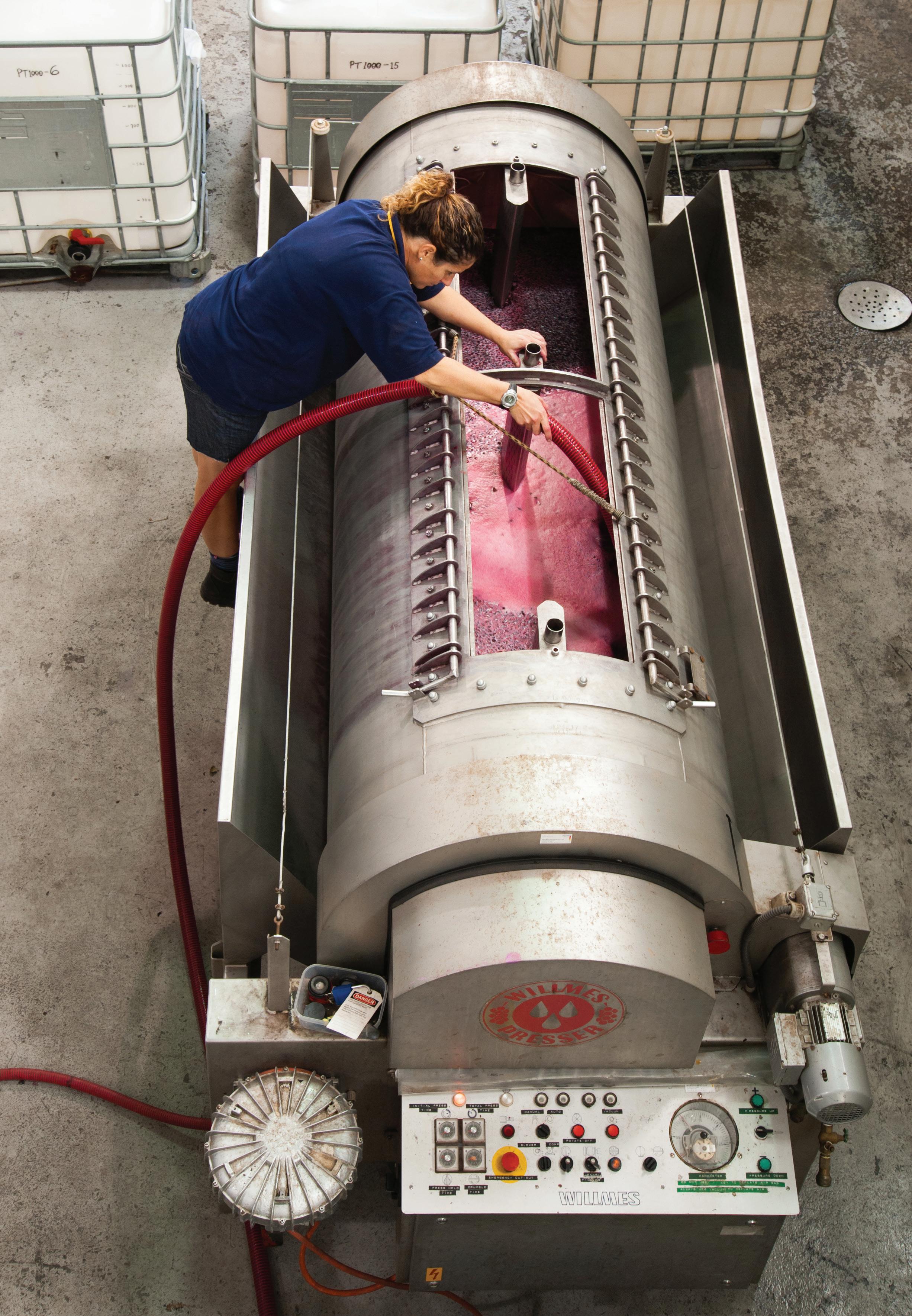
50 pump industry | Winter 2023 | Issue 44 www.pumpindustry.com.au FOOD
Centrifugal pumps
Centrifugal pumps are a type of rotodynamic pump, which has a shaft-mounted impeller that rotates unidirectionally within the pump casing, moving the liquid from the low-pressure area at the center of the impeller to the higher-pressure zone at the edge of the impeller.
These pumps are more common in large wineries, and are often used for transferring wine from one tank to another. These pumps are easy to maintain and clean, inexpensive, and offer high flow rates. As they do not produce a high discharge pressure, there is minimal risk of containers or hoses rupturing.
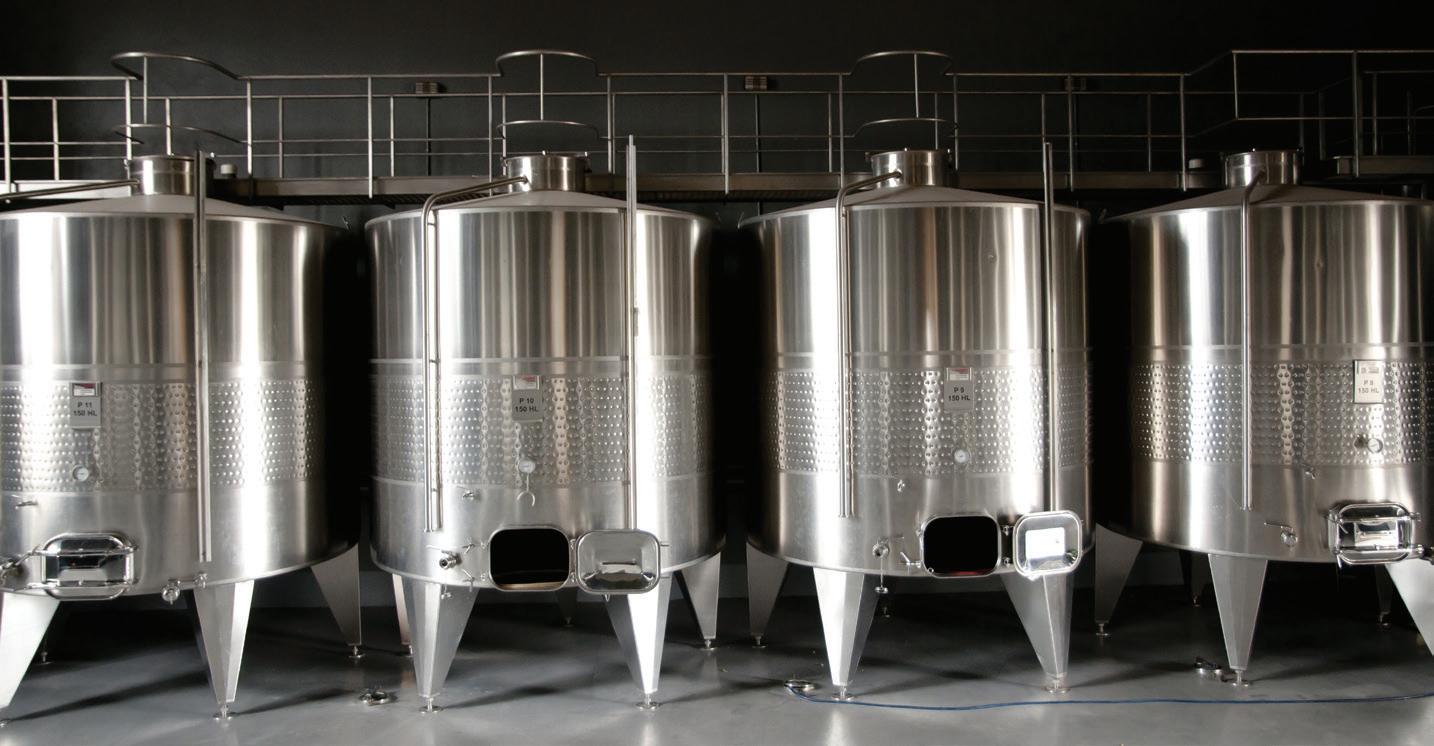
The nature of this design however means that the wine will experience significant shearing and agitation while passing through the impeller. Centrifugal pumps also have the potential to homogenise air and trap the oxygen in wine, resulting in oxidation that adversely affects the taste of the wine.
Progressive cavity pumps
Progressive cavity pumps are a type of positive displacement pump, which work by turning a helical rotor within a helix-shaped elastomeric stator. The metal rotor drives the stator through the chain and begins to fill the cavities with equal amounts of liquid that is then pushed through the pump outlet. These pumps are easy to clean, self-priming, portable and easily variable between high and low-flow rates. As they are also highly tolerant of solids and minimise the shearing and agitation of the pumped fluid, they are ideal for pumping must and extracting juice.
The setback to these pumps is their susceptibility to damage in dry-run conditions, where the pump’s contents can burn and seize if it continues to operate after all the wine has been processed. As the winemaking process relies on manualbatch production operation, this can make these dry-running conditions a common occurrence. As the stator and rotor begin to wear down, there is also the risk of rubber shavings entering the product stream, contaminating the precious wine, and as such preventive maintenance is recommended.
Lobe pumps
A lobe pump (or rotary lobe pump), is another type of positive displacement pump that uses rotating “lobes” to generate flow and move fluid around the interior of the pump. These lobes are driven by external timing gears situated in the gearbox, meaning each lobe rotates independently to generate flow. The external timing gears also prevent the lobes from making contact with each other.
These pumps are commonly used in wine applications, as well as other industries where hygiene is of particular concern, as they offer excellent sanitary qualities along with a high degree of efficiency, reliability, and good clean in place capabilities. In addition to being easily reversible, their portability and low-shear properties also makes lobe pumps favourable for winemaking.
Because the rotating lobes are non-contacting, and clearances within the pump are not as tight as other positive displacement pumps, they generally struggle with lower viscosity fluids, so it's important to consult the manufacturer on whether a particular pump is suitable for its intended application.
Lobe pumps also include a seal, which increases the risk of leakage. These pumps have ability to handle some suspended solids, however In order to be suitable for must, a larger model is generally required, which can make transfer between wineries more difficult.
Peristaltic pumps
A peristaltic pump (or hose/tube pumps) is another variation of a positive displacement pump that operates on the peristaltic principle. The pump works by turning a lobed shaft that progressively squeezes a soft tube filled with fluid, which pushes the fluid out of the pump on the high-pressure side of the housing. Peristaltic pumps are self-priming, easy to clean, and can run dry. They are also incredibly gentle on fluids and their ability to handle solids makes them suitable for must. However, as the rubber hoses are prone to shedding with age, they need to be changed regularly to prevent contamination.
Diaphragm pumps
Diaphragm pumps are positive displacement pumps that work by contracting a rubber diaphragm to pull fluid into a chamber through an inlet valve, the diaphragm then expands to push fluid out of the chamber through an outlet valve. These pumps are incredibly versatile and are a popular choice in the wine industry thanks to their gentle handling of the wine. Diaphragm pumps are low-maintenance, highly portable, easy to clean, and can run dry. As they also have no seals, there is minimal risk of leakage and contamination of the wine.
Flexible impeller pumps
A type of positive displacement pump, flexible impeller (or flexible member / flexible vane) pumps use a rubber impeller that rotates and creates a vacuum to draw the fluid into the pump inlet, which is then carried between the blades of the impeller and the casing, before being directed to and pushed out of the discharge. These pumps are easy to clean, offer high flow capacity, and can run at different speeds and accommodate differing viscosity types. This pump offers a gentle pumping action that ensures the consistency of the fluid is unaffected by shear forces. While they are ideal for transferring wine, flexible impeller pumps struggle with moving solids, making them unsuitable for transferring wine must. These pumps will also overheat if they run dry, which will damage both the pump and the wine.
Like the grape varietals themselves, each type of wine pump has its own unique characteristics that will shine in the right application, or fail given the wrong conditions. Depending on the size, scale and varietals used in a vineyard, the requirements of a wine pump will vary, and the best way to ensure that you are choosing the right pump for a winemaking application is to consult a pump supplier or industry expert.
51 www.pumpindustry.com.au pump industry | Winter 2023 | Issue 44
FOOD
HOT STUFF: HOW HEAT PUMPS CAN HELP DECARBONISE THE MEAT PROCESSING INDUSTRY
By Steph Barker, Journalist, Pump Industry Magazine

Around half the energy used by the Australian manufacturing industry is due to industrial process heat. Kyneton-based meat producer Hardwick Processors took part in an ARENA-funded study on replacing fossil-fuelled process heating technologies in manufacturing industries with renewables-powered alternatives, and found that heat pumps played a key role in reducing their reliance on natural gas.
52 pump industry | Winter 2023 | Issue 44 www.pumpindustry.com.au
FOOD
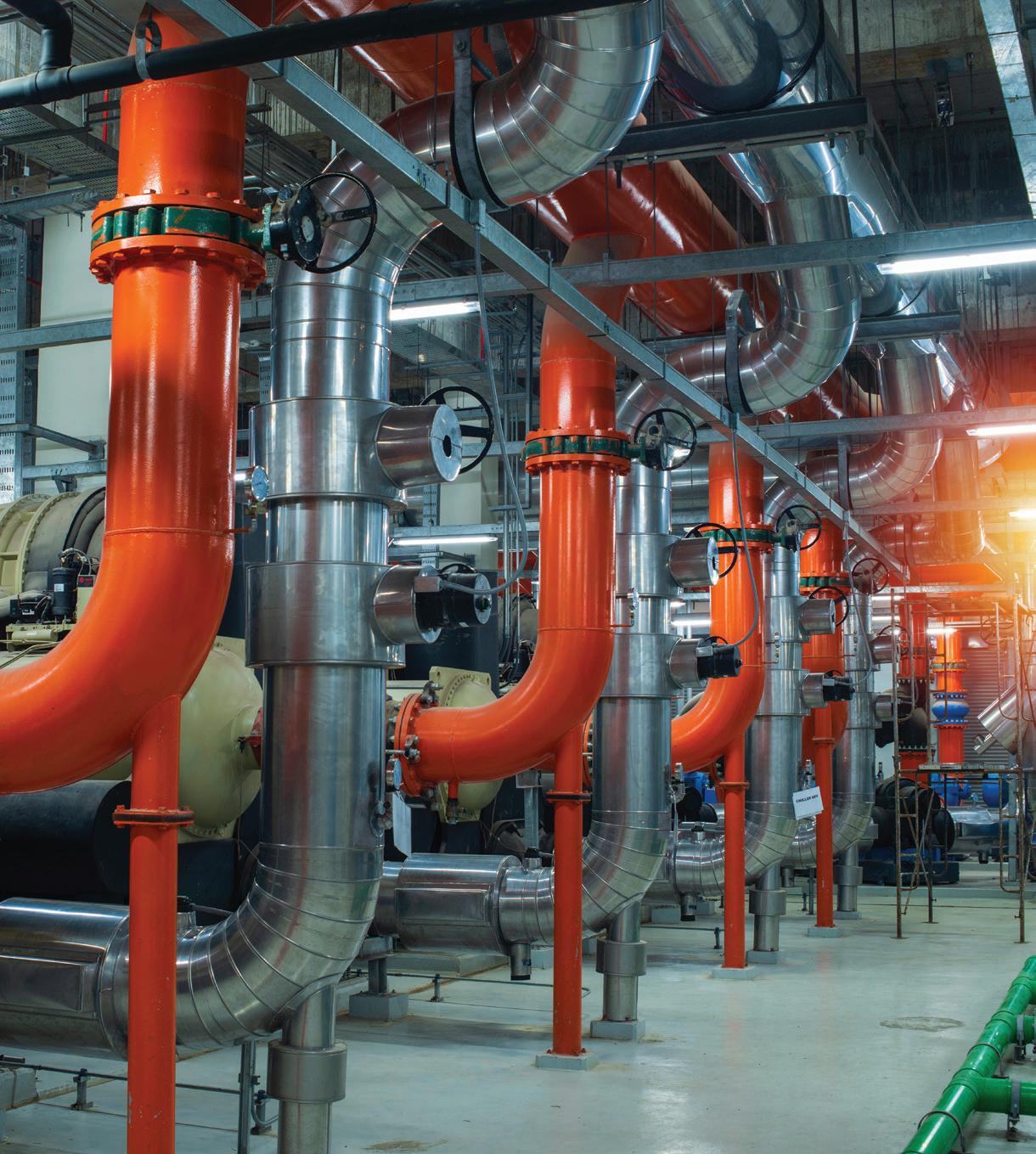
In 2019, the Australian Renewable Energy Agency (ARENA), in conjunction with the Australian Alliance for Energy Productivity (A2EP), funded the Renewable Energy for Process Heat Opportunity Study. The study sought to determine the technical and commercial feasibility of replacing fossil-fuelled process heating technologies in manufacturing industries with renewables-powered alternatives and provide detailed pathways to implementation. At that time, ARENA said process heating was responsible for the largest share of fossil fuel use in Australian manufacturing, accounting for more than 40 per cent of use in the industry.
Twenty pre-feasibility and seven feasibility studies were completed over two phases, covering a range of food, beverage and industrial processes. The studies considered the suitability of renewable energy options for these industries and applications – with a particular consideration of industrial heat pumps. Kyneton-based meat producer Hardwick Processors was one of the seven manufacturers selected for a feasibility study. Hardwicks is a family-owned retailer and meat processor, which is run from a purpose built, state of the art facility at Kyneton in the Macedon Ranges, Victoria.
Hardwicks was an ideal candidate for the study. The meat processing plant had been using a heat pump, which ran on non-renewable fuel, used for low temperature (~80°C) industrial process heat applications. According to ARENA, these types of heat pumps are amongst the most accessible to supply with renewable energy, as heat pumps operate comfortably in this temperature range and can be powered with renewable energy. Despite this, around half of the total energy used by Australian industry is due to industrial process heat, typically using natural gas. ARENA identified the key barriers to increased uptake of renewable energy in the manufacturing sector as:
• The need (in some cases) for increased electrical supply capacity
• Low awareness and capability among technical service providers
• High capital cost of equipment compared with incumbent gas-fired boilers
• A need to operate at high capacity factors, often using thermal storage, to achieve an acceptable economic return
Reducing the reliance on natural gas for process heat represents a significant opportunity to decarbonise the Australian manufacturing industry and help companies save on potentially expensive gas. Hardwicks had already installed on-site renewable energy infrastructure of 2.5MW solar PV and a 2MWh battery storage system, making them an ideal candidate for the case study and solidifying their commitment to renewables.
Feasibility findings
The pre-feasibility and feasibility studies demonstrated that industrial heat pumps are economically and technically feasible for low temperature (<90˚C) heating applications, and can be superior to other renewable heating solutions (such as solar thermal or biogas from anaerobic digestion) where conditions are ideal – such as suitable temperatures, high-capacity factors and opportunities to integrate heating and cooling.
For Hardwicks, the feasibility study found that a smaller and less expensive heat pump, run continuously, and storing hot water in existing thermal storage tanks, would be the most efficient way of producing process heat. The new heat pump would connect to the existing renewable infrastructure, reducing reliance on gas and grid power. However, making these changes would require additional changes to existing infrastructure to incorporate the new additions into the plant’s existing equipment.
The success of the feasibility study prompted ARENA to allocate funding for Hardwicks as part of its Advancing Renewables Program. The program offered grants to support businesses with funding or finance to develop renewable energy technologies, including optimising the transition to renewable electricity, commercialising clean hydrogen and supporting the transition to low emissions metals. Hardwicks received funding of $838,000 to install a 1MW (thermal) demonstration scale heat pump and to upgrade the electrical supply system at its meat processing plant in Kyneton.
Transition challenges
As part of the grant requirements, Hardwicks reported on lessons learned during the project’s implementation. The reports identified key challenges and how Hardwicks solved them, also providing advice for future uptake for similar businesses. The first challenge for Hardwicks came in the days leading up to the scheduled works, with Hardwicks’ network provider advising that they required a major communications device to remotely monitor and control the existing renewable assets of battery and solar. The battery and solar assets were vital to the project as they were to be used to power the new heat pump.
Hardwicks decided to move forward with the upgrade to keep the project on schedule, with the renewable assets being taken offline until the communications works could be executed. Hardwicks also wanted to reconfigure their renewable assets as part of the power upgrade. These works had not been commissioned as part of the project, presenting significant short term cost implications and requiring additional grid power while the devices were offline. The field of renewable assets and having many small generators was a new area for the network provider to manage, adding to the difficulty and complexity of the transition.
Despite the challenges, Hardwicks said the network provider was very responsive and did everything in their power to get the renewable assets back on line as quickly as possible. Hardwicks noted that a potential fix for the issue would be to have more formal face-to-face meetings with all the parties
53 www.pumpindustry.com.au pump industry | Winter 2023 | Issue 44
FOOD

involved in the planning stages of the project, as this may have helped to identify potential problems and flag the issue at an earlier stage.
Another hurdle came with a scope change early on in the project’s execution. Prior to undertaking, the battery and solar assets fed back into the existing main low voltage (LV) switchboard. At the project’s conception, it was intended to maintain this arrangement to reduce both the complexity of the project and the number of modifications required to existing assets. However, Hardwicks agreed to upgrade their electrical supply system to become a high voltage (HV) customer, taking any excess electricity required from the Powercor network. The HV upgrade was to ensure that the renewable assets fed into the plant at the head of the system, and balanced systematic distribution of renewable assets across the entire plant – including new electrical infrastructure and existing electrical assets. It would also provide valuable insights into the electrical supply infrastructure requirements associated with electrifying process heat for industrial use.
Because the network providers were inexperienced with the integration of small generation sources, the power upgrade works were delayed. The power change over from LV to HV was scheduled to occur at the end of October 2022, but didn’t take place until the start of December 2022. Thankfully, the delay had little impact on production. Hardwicks advised that integration of renewable assets into a HV upgrade should be included in the HV installation, to allow more straightforward upgrades for future renewable upgrades. For complex integration works such as this, which involve both enhanced communication and renewable integration into the grid, very detailed planning and implementation needs to be factored into the works program regardless of the experience of stakeholders. In addition, increased stakeholder meetings need to be considered to ensure understanding and capability of stakeholders meets the requirements of the project.
As the project continued, Hardwicks found that retrofitting the heat pump and completing the HV upgrade to an existing plant required a large amount of work and analysis
on Programmable Logic Controllers (PLC). A PLC is an industrial mini computer that can receive data through its inputs and send operating instructions through its outputs. Fundamentally, PLCs operate key pieces of machinery, ensuring logical programming of events and communication between components. Most of the pumps in Hardwicks processing facility were run by PLCs, which included:
• A cold-water supply pump to fill the heat recovery tank. A level transducer measures the level in the tank and opens a control valve when the tank level drops.
• A primary supply pump driven locally from the output of a pressure transducer. The pump speed is varied to maintain a constant outlet head. This is designed to cater for the total flow downstream through the three heat recovery units on the screw compressor oil cooling circuits as well as the required water flow through the heat pump heat exchanger.
• Water supply to the heat pump, which is initiated once the heat pump compressor is operating. A valve is modulated when the heat pump compressor is started. When the pre-heat tank is in full flow and the hot water supply pump is switched off, the heat pump is instructed to switch off. This water flow condition is triggered by monitoring the water flow meter output on the heat pump water line. Once flow through the flow meter is reinstated, the heat pump will restart.
• Water supply to each of the three oil heat recovery units is initiated by opening three valves when each of the corresponding ammonia compressors are operating. Oil return temperature is measured on each of these compressors. If the oil return temperature measured is too high, it will trigger the existing oil cooling water pumps to switch on thus providing incremental cooling to each of the compressors oil circuits. Once oil temperature returns to the required set point the oil cooling water pumps will then switch off. If the return temperature monitored is too low it will trigger the three control valves to close. As the oil temperature increases and reaches the required level, then the valve will reopen.
54 pump industry | Winter 2023 | Issue 44 www.pumpindustry.com.au FOOD
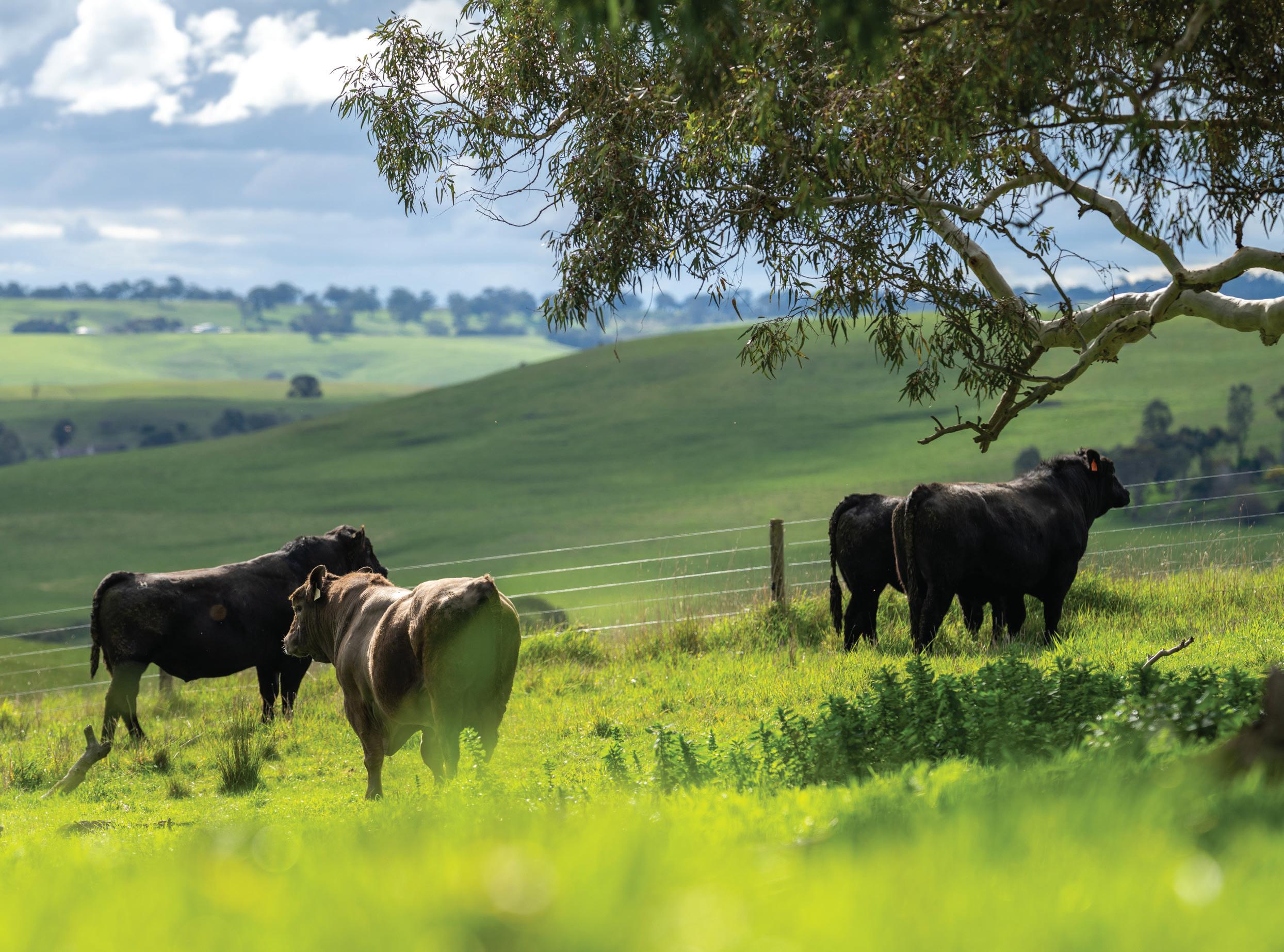
Adding the new equipment presented a big challenge, as the PLCs required reprogramming to incorporate the new equipment and ensure that all the systems were able to communicate. Hardwicks navigated this by working with the existing refrigeration contractor, which helped to ensure that the heat pump was optimally integrated into the existing plant. Hardwicks found that having long-term relationships with specialist contractors helped to de-risk projects, and was especially critical in this project. A large amount of plumbing and electrical works were carried out or supervised by Hardwicks internal tradesmen, and the refrigeration and heat pump works were carried out by the company’s main refrigeration contractor – who has carried out all works on the site for the past 25 years. By using internal tradespeople and contractors with direct experience, Hardwicks ensured that maintenance staff had a very strong understanding of the operating system and could integrate the new assets without disrupting the existing plant operations.
A final challenge came from the initial analysis for the heat pump project. The analysis was carried out over three years prior to project completion, largely due to the availability of funding to support the investigation. Like many manufacturers, meat processing plants can be very dynamic, with production levels changing dramatically due to seasonal changes, weather patterns and world markets. Plants can very rapidly change production levels over a short period – most plants are continually driving to increase volume, which delivers the highest economical outcome during prosperous times.
Due to the variable production levels, water usage can regularly vary in excess of plus or minus 20 per cent. For Hardwicks, between the first analysis and the completion of
the installation of the heat pump, water usage across the site increased by 20 per cent. The project team managed this by balancing the heat pump hot water generation with the varying hot water demands of the processing plant. Hardwicks said it is important to consider what flexibility is required to allow for operational variabilities of a processing facility. For this project, natural gas continues to provide some of the final heating, which has built greater flexibility into the project. It is important to obtain existing usage data (for this project, water and ammonia usage), to ensure that the scope of the project covers both ends of the usage spectrum. Although this data monitoring can be a big expense prior to the commitment of moving forward with a project, it reduces the risk of incorrect equipment size selection and the need to further rely on nonrenewable energy to make up any shortfalls.
Decarbonising the future
The Hardwicks case study shows the potential for decarbonising the meat industry. While there are many challenges along the way, early planning with all stakeholders can help mitigate potential problems that may arise further down the road. Hardwicks successful installation also highlights the importance of contractor experience and building relationships – intimate knowledge of existing operations goes a long way in helping to introduce new assets with minimal interruption and downtime. Finally, understanding the full scope of a manufacturer’s operations is vital – research needs to account for the inherently variable nature of manufacturing production, ensuring that both ends of the spectrum can be supported by renewable energy.
55 www.pumpindustry.com.au pump industry | Winter 2023 | Issue 44 FOOD

HAY SHIRE’S PUMPING FLOOD RECOVERY
56 pump industry | Winter 2023 | Issue 44 www.pumpindustry.com.au PROJECT
By Tess Macallan, Journalist, Pump Industry Magazine



Following severe flooding in 2022, New South Wales’ Hay Shire Council began repairing a culvert that had spent months underwater and made a mammoth discovery. Council was faced with a 40m long, 15m wide chasm filled with water. Managing the impacts of the floods and draining the inundated roads has required significant resources, including a number of pumps.
In late 2022, floodwater from the Lachlan and Murrumbidgee rivers, along with months of rain, transformed the landscape of Hay Plains – one of the flattest regions in the world.
Roads and properties were inundated with water, cutting off access and severely impacting the entire Hay Shire community. The region continues to experience the lingering effects of the floods.
Greg Stewart, Operations Manager, Hay Shire Council, said, “Following the floods, 20 roads were closed.
“We currently have one road closed, however, all the others are operating at minimal traffic levels.”
Pumps played a crucial role in managing and recovering from the floods, assisting with water control and removal.
“Council had 36 pumps set up at stormwater outlets that were closed due to the high water levels at Murrumbidgee River,” Mr Stewart said.
“These pumps were monitored on shift rotations 24/7. When we experienced rainfall within the levee we had to start all the pumps in a strategic sequence to prevent flooding within the levee.
“The pumps were from a mixture of Council and local contractors and ranged from one to twelve inches depending on the catchment.”
The great chasm
Prolonged flooding resulted in the formation of a colossalsized hole around a culvert on Booligal-Gunbar Road.
“Booligal-Gunbar Road has a series of large culverts underneath it through which Gum Creek runs,” Mr Stewart said.
“The culvert pipes did not have the capacity to allow this volume and flow of water to pass through and as a consequence the water breached the road along a 300m section at the creek.
“As the creek continued to rise the water spread out and began to scour a section of road outside the creek channel where there were no culverts. This part of the road became sacrificial and as the scouring continued, the water was concentrated in this area. The volume and flows were so great it carved its own path through the road.
“At this point, the only action Council could take was to shut the road.”
It wasn’t until two months later, after the water had receded, that Council was able to build an earth bank on each side of the
road to block the flow and allow pumping of the water. At the time, the depth of the washout was unknown.
“Initially, Council had two three-inch pumps sent to site to move the water and allow repairs to take place,” Mr Stewart said.
“It soon became a reality the hole was greater than expected and two more four-inch pumps were deployed to assist. After three days of pumping, we could see the floor of the washout.
“Council was also required to import fill material from a borrow pit 10km from the washout site, to replace the lost material.
“A combination of Contractor and Council plants won and imported the fill material. This work took six to eight days to complete as the washout was built up in 300mm compacted layers.”
Under the pump
Mr Stewart said the work was challenging due to the fact there was only enough space for one truck to access the washout at any given time.
“This didn’t impact the scope of the works, it just took longer given the size of the hole.”
Another challenge was finding enough earthmoving plant to undertake the work.
“Most Councils and farmers were faced with similar issues and we were all competing for the same earthmoving equipment,” Mr Stewart said.
“We were fortunate enough to partner with a mixture of local contractors and Council resources.”
Council is currently faced with another large washout in the west of the LGA.
“Access to this road has only been available the last two weeks,” Mr Stewart said.
“We are repairing this washout similarly to the BooligalGunbar washout. Pumps are yet to be sent to remove the water and it is expected we will send out three four-inch pumps.”
Mr Stewart said Council has been fortunate to have active contractors and suppliers willing to assist during this time and provide pumps and fittings given the demand across New South Wales.
As extreme weather events grow more frequent due to climate change, parts of Australia will face an increase in severe flood events, necessitating the use of pumps for water management and flood recovery.
57 www.pumpindustry.com.au pump industry | Winter 2023 | Issue 44
PROJECT
URBAN UTILITIES INVESTS $65M IN MAJOR PUM P INFRASTRUCTURE
One of Australia’s largest water and wastewater services providers, Urban Utilities, is upgrading major pump infrastructure to support growth and development in South East Queensland.
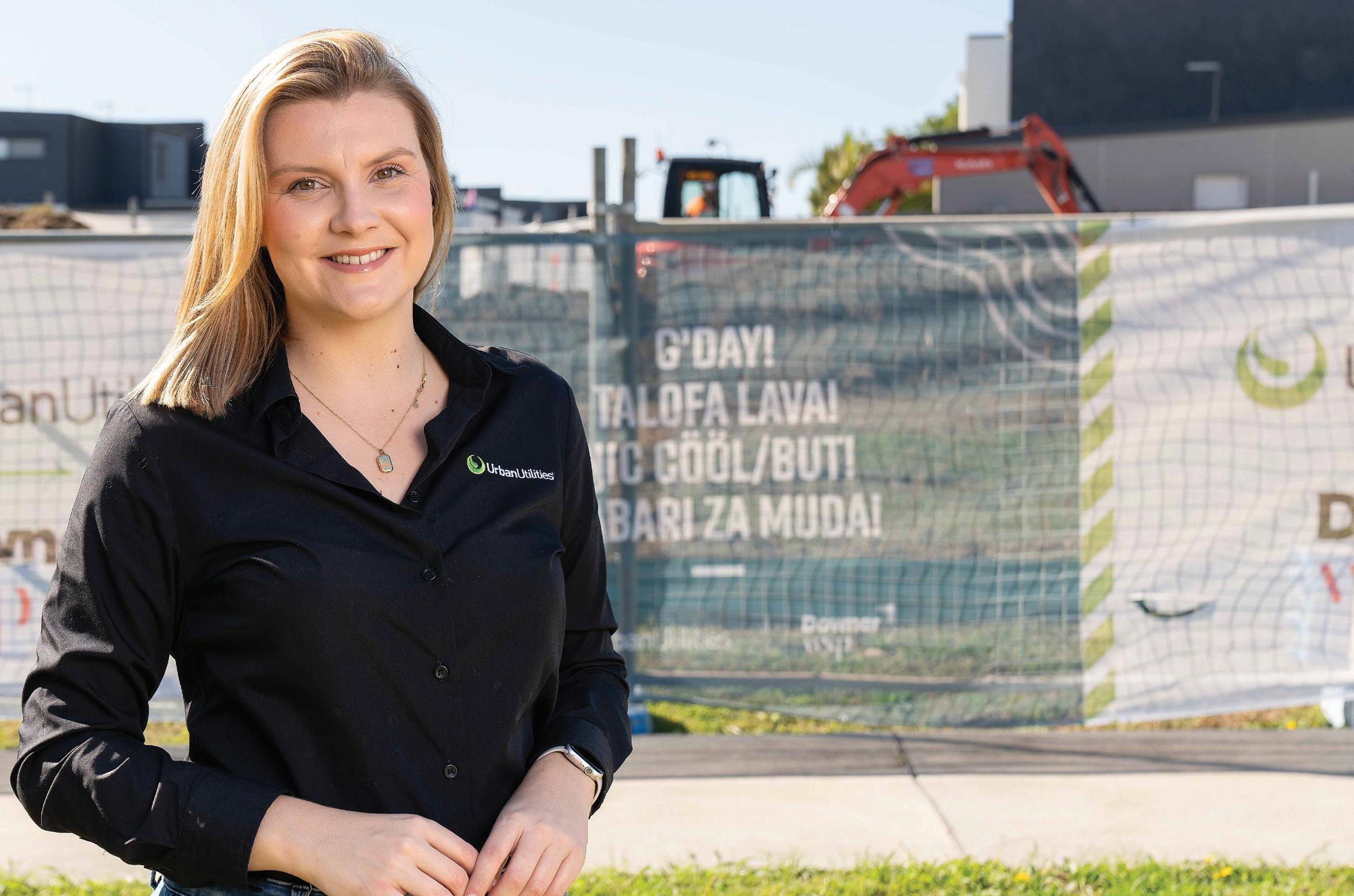
Across its service region, Urban Utilities has around 340 wastewater pump stations, 90 water booster stations and more than 60 water pump stations that help it provide essential services to more than 1.6 million people in the Brisbane, Ipswich, Scenic Rim, Lockyer Valley and Somerset council areas.
The utility plans to invest more than $65 million in essential pump station infrastructure across its service region over the next 12 months, including the completion of new water and wastewater pump stations in the rapidly growing areas of Ipswich and the Lockyer Valley.
Taking a Lockyer Valley pump station underground
One of the major projects to cater to growth in the Lockyer Valley, west of Brisbane, includes Urban Utilities’ $21 million Plainland Wastewater Pump Station upgrade.
Urban Utilities spokesperson Anna Hartley said the project would cater for growth in the area through to 2040.
“It’s important we upgrade our existing network and build new infrastructure for the future so we can continue to provide safe and reliable water and wastewater services to our customers,” Ms Hartley said.
“As part of the upgrade, we are constructing a new wastewater pump station at Plainland and a 7.2km pipe to connect the Plainland pump station to the existing Laidley Wastewater Treatment Plant.
“The works will mean we’ll be able to cater to development as more people call the area home.
“The new pump station will have the capacity to transport wastewater from up to 3000 residents in the area, at 30 litres per second.
“As an additional benefit, it will also replace our existing tankering facility, providing improved wastewater services for our regional customers in the area, reducing vehicle movements and enhancing our operations in the Plainland and Laidley communities.”
Ms Hartley said the original design of the wastewater pump station was revised when those leading the project recognised the site would be able to accommodate the majority of infrastructure below ground.
“The original design proposed two-stages of pumping, which included submersible to positive displacement pumps,” Ms Hartley said.
“Through detailed design and confirmation of the system hydraulics, the team was able to remove the second stage of pumping, using duty, or standby, submersible pumps located in a wet well as part of the project.
“These pumps were chosen based on the system hydraulics.
“This minimised the extent of above-ground equipment on site and meant the majority of pump station infrastructure was able to be installed below ground on site, providing
58 pump industry | Winter 2023 | Issue 44 www.pumpindustry.com.au
PROJECT
Urban Utilities begins work to support growth in Ipswich Urban Utilities Spokesperson Emily Arnold
aesthetic benefits and reducing any potential noise and odour impacts to the nearby community.”
The designs involved a combined grit chamber and wet well in a single structure with a dividing wall.
“Pumps transfer wastewater flows through the new sewer rising main to the nearby Laidley Wastewater Treatment Plant to be safely treated,” Ms Hartley said.
To further minimise any potential community disruption as part of the major project, Urban Utilities is using trenchless technology where appropriate to install the new rising main below ground.
“By using innovative trenchless technology to install part of the pipeline that will connect the new pump station to the existing treatment facility, we were able to minimise any traffic impacts to the popular Warrego Highway,” Ms Hartley said.
“This approach will also allow us to complete the rising main install quickly and efficiently as we work to complete this important upgrade.”
Urban Utilities plans to complete construction and commission the new Plainland Wastewater Pump Station by the end of 2023.
Water pump station to support growth and industry in Ipswich
The utility, which manages a complex 19,000km water and wastewater pipe network across Queensland’s South East, has also started work on a $9.4 million project to build a new water pump station in Ipswich to help cater for future growth.
The new pump station is being built in Redbank Plains, where the population is expected to increase from 10,000 to 30,000 by 2045.
Urban Utilities spokesperson Emily Arnold said that the project would enhance water service reliability while also helping to future-proof the region.
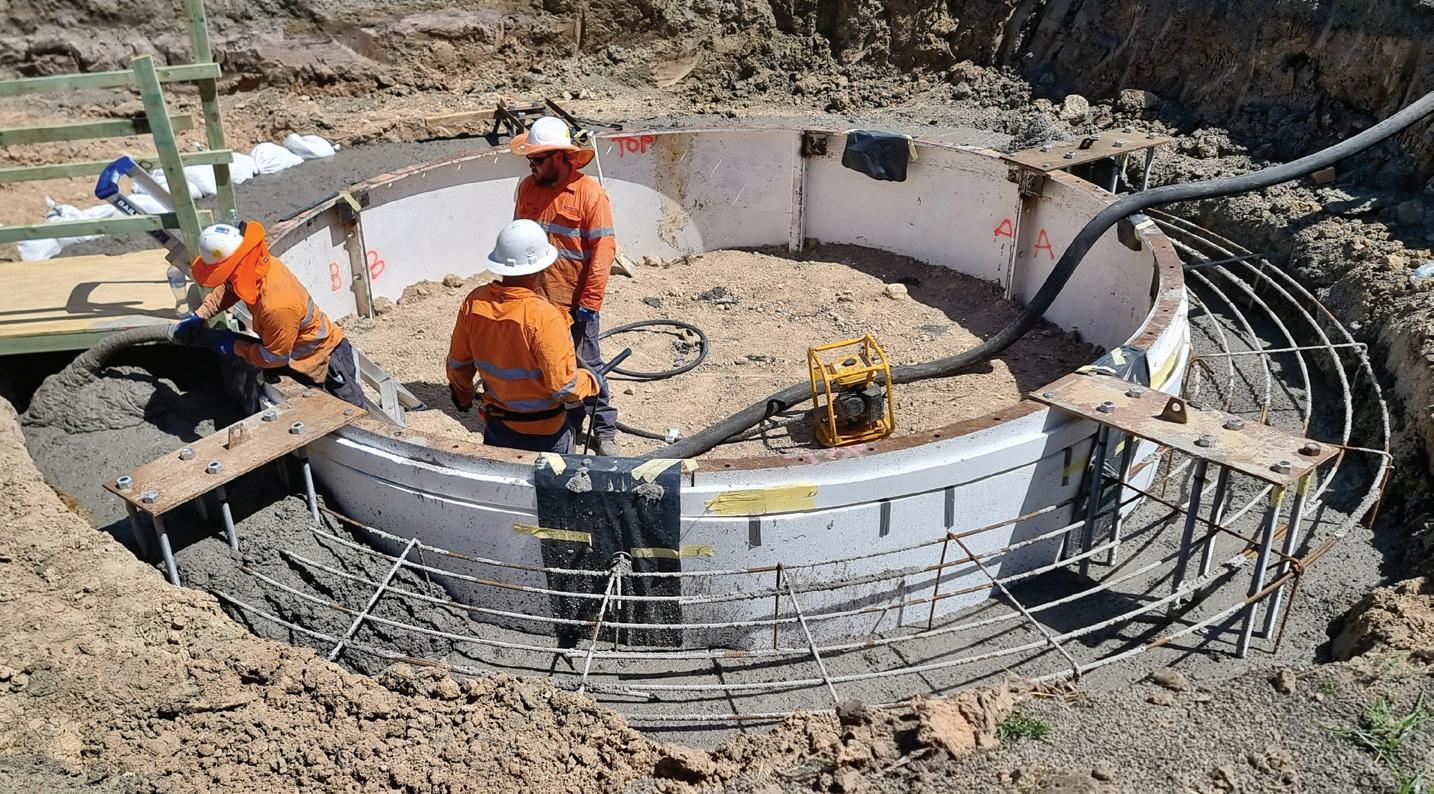


“The project involves the construction of a new water pump station building, containing six water booster pumps as well as valves, pipework and electrical equipment,” she said.
“This area’s population is expected to almost triple in the next two decades, and our new water pump station will be an essential asset that will allow us to continue to provide safe, reliable drinking water to this community for years to come.
“We’ve also worked alongside our delivery partners, Downer WSP, to ensure the new water pump station is visually appealing, with the planned architectural design factoring in surrounding residents to blend the pump infrastructure into its surrounds.”
Ms Arnold said the water pump station would help service the growing number of residents and businesses across the region, as well as larger industrial customers.
“This important project will deliver water supply to a new development in nearby Ripley Valley, and to the Swanbank industrial area, which will include a planned beverage manufacturing facility that is currently under construction,” she said.
“Important projects like this are part of our capital program which supports growth, development and jobs in our communities while ensuring we continue to deliver safe and reliable water and sewerage services for our customers.”
This project is also expected to be completed by the end of 2023.
59 www.pumpindustry.com.au pump industry | Winter 2023 | Issue 44
PROJECT
The project will support growth in the Lockyer Valley and improve wastewater services for the region
Lockyer Valley Regional Council Mayor Tanya Milligan and Anna Hartley from Urban Utilities
For more on how Urban Utilities is helping to prepare for growth in South East Queensland, visit watertalk.urbanutilities.com.au
The proposed Ipswich water pump station will cater for residential, business and industry growth in the area

INTAKE DESIGN Part 1
60 pump industry | Winter 2023 | Issue 44 www.pumpindustry.com.au PUMP HANDBOOK

61 www.pumpindustry.com.au pump industry | Winter 2023 | Issue 44 PUMP HANDBOOK
The PIA’s Australian Pump Technical Handbook is a cornerstone text for the Australian pump industry and, in our opinion, a must have for anyone who deals with pumps on a regular basis. In this ongoing series, we feature abridged chapters from the classic book to showcase the various areas covered and to reacquaint readers with the technical aspects of pumps. In this issue we take a close look at intake design.
It is important that the intake of a pump station is designed correctly. This first part discusses potential problems that can occur and how they can be observed and what are their consequences.
An unsatisfactory hydraulic design of an intake or sump can have far-reaching implications on the overall performance of a pumping station.
The fluids under consideration are water and air, the water being pumped and the air being above the free surface or, in some cases, being entrained in the water. However, the results will apply in principle to other fluids used in process industries as long as allowance is made for effects arising from the difference in the fluid properties. Viscosity and density are the most important properties to be considered.
Poor hydraulic design of a pump sump and intake could arise because of insufficient consideration at the design stage or because of site constraints. A summary of the possible consequences is as follows.
Air gulping
With water level at or only just above the top of the intake there will be a tendency for the air to be drawn into the intake either continuously or intermittently in the form of gulps. There may be a distinct local depression in the water surface adjacent to the intake, described as “drawdown”, which may accentuate the problem. High intake velocities will also cause increased air flow rates into the intake. The basic reason for this condition is that the sump water level is too low with not enough cover above the intake.
In extreme cases the pump may lose prime and the delivery will fall to zero. If the pump does continue to deliver water, it will also discharge large quantities of air, which may cause serious problems in the system. For example, the pump may be supplying cooling water to a condenser where air would cause overheating of the tubes. Large quantities of air passing through a pump impeller may cause uneven loading resulting in vibration, rough running and possible damage to the bearings in a fairly short time. Although there is not much published data on changes in performance due to air entrainment, it is known that air in quite small quantities can lead to a reduction in discharge and loss in efficiency. In a typical case, a centrifugal pump with three per cent free air showed a drop in efficiency of 1.5 per cent; however, actual figures depend very much on the type of pump (axial flow pumps being more sensitive to entrained air than centrifugal pumps). Normal design practice should be to exclude all air. This implies that there should be no air entraining vortices at the intake and that there should be no air entrained in the approach flow to the intake due to other causes.
Aerated
Air bubbles may exist in the water of a sump for a variety of reasons, but they are usually due to a falling water jet as the water enters the sump from a weir or culvert that is above the sump water level. If there is insufficient time for air bubbles to
rise to the water surface before they are carried close to the intake section, they will enter the intake and be carried into the pump.
It is best to avoid high level entry into the sump, but if this is not possible, then, sufficient separation should be provided from the source of aeration at the intake to allow the air bubbles to rise to the surface of the water in the sump. Approximate calculations based on the mean horizontal velocity in the sump, the minimum rise velocity of the air bubbles and water depth in the sump, can be used to determine the separation distance. A typical minimum figure for the rise velocity is 0.2m/s based on air bubbles between 2–5mm diametre. Obviously, larger bubbles will rise faster and so reach the water surface before the smaller bubbles. However there is an important class of intake used for sewerage where this procedure cannot always be used and so some air entrainment into the pump may have to be accepted.
Similar to that for air gulping above, the severity depends on the quantity of air and type of pump.
Air entraining vortices
The extreme case of a steady vortex with an air core between the water surface and the intake feeds air directly into the pump. In less severe cases, the air may enter only intermittently with the vortex being unsteady and less developed. Even if no air is drawn in, the swirling flow associated with the surface can cause problems. Asymmetry or pre-rotation in the flow approaching an intake coupled with stagnant regions of water above or near the intake, increase the chances of air-entraining vortices forming.
Similar to that for air gulping above, the severity depends on the quantity of air and the pump type. There are also effects similar to submerged vortices and swirling flow below, the severity depending on the vortex strength and the pump type.
Submerged vortices
These vortices originate from the side walls and the floor of the sump rather than the water surface. In modelling, the vortex core can be seen by injecting dye into the water near where a vortex is anticipated. Sometimes the vortex may be visible as small air bubbles in the water that are centrifuged into the core. There is also the possibility that air in the solution can be released by the very low pressure in the rapidly rotating core.
There is not a great deal known about the origin of submerged vortices except that they probably stem from swirl in the approach flow and vortices in the boundary layers on the sump floor and sides. The presence of a submerged vortex core indicates that there is appreciable swirl in the well.
Rapid changes in local pressure in the pump impeller as a vortex core is ingested can cause severe vibration and cavitation. Axial flow pumps are generally more susceptible to damage from vortices than other types of pumps.
62 pump industry | Winter 2023 | Issue 44 www.pumpindustry.com.au PUMP HANDBOOK
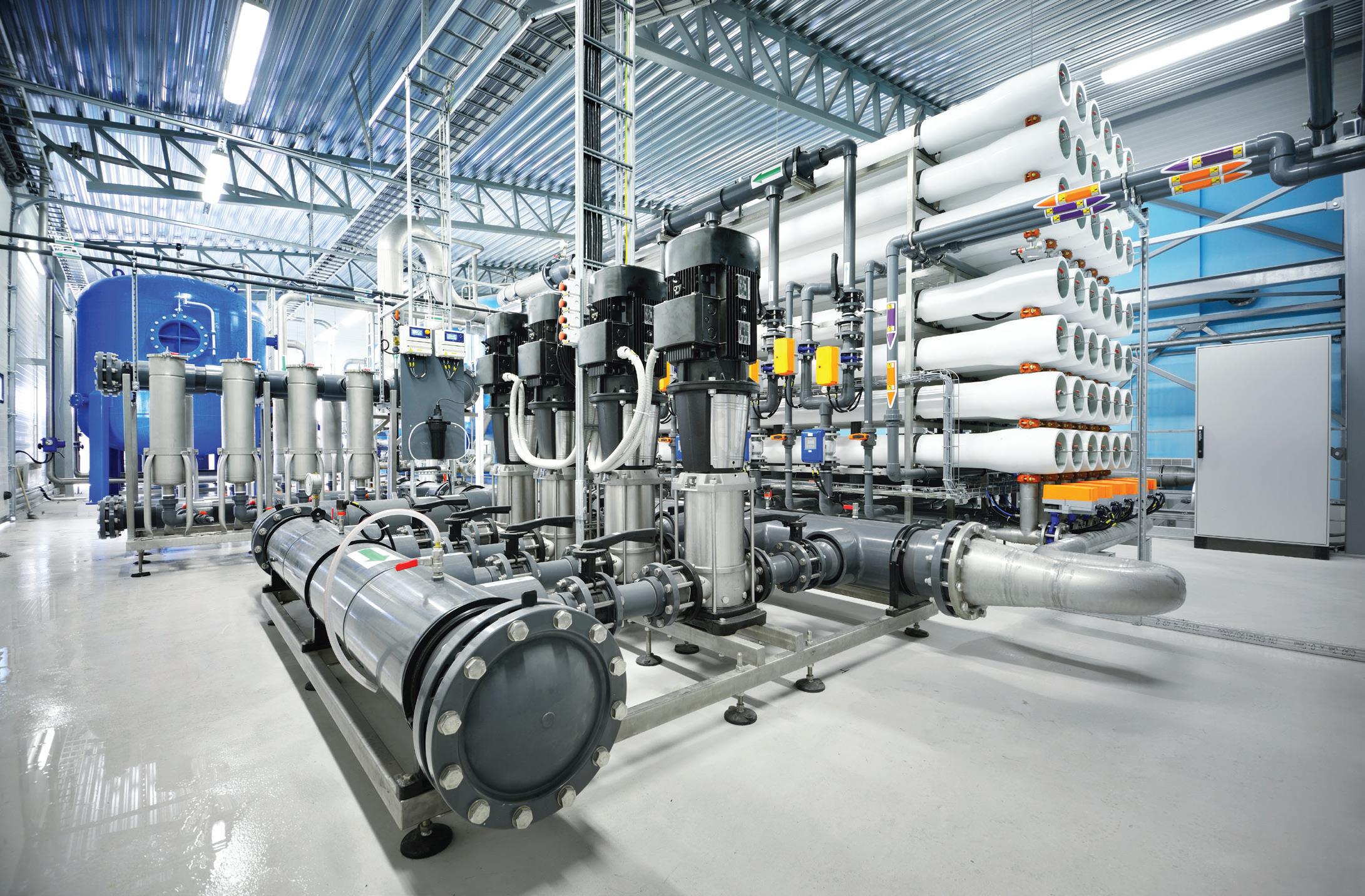
Swirling flow
Swirling flow is usually caused by large scale rotation in the bulk of the fluid in the sump which is then amplified as the flow converges into the intake. In many cases the swirl may be accompanied by a rapidly rotating inner core even if there is no surface vortex visible.
Severe swirling flow is the same as for submerged vortices above, but there is an additional effect, when the swirl is on a larger and less intense scale but is centred on the pump axis. In this case, there can be a gain or reduction in the pump performance depending on the relative directions of the swirl and pump impeller. This effect is most noticeable in axial flow and mixed flow pumps.
Large scale turbulence
In this case the eddy size is the same order of magnitude as the intakes cross section area. Unsteady flow patterns arising from obstructions in the sump or poor inlet conditions into the sump are the primary cause. Vortex shedding from pillars or other pumps is a common cause.
Uneven blade loading, changing with time may cause vibration and noise in the pump. This effect will be worse when the pump is very close to the intake section as in a vertical suspended wet well installation. If there is a moderate length of conduit between the intake and the pump (say more than 10 diameters) or if there are several bends and changes of cross section, the initial turbulence may not be so important in defining the flow conditions at the pump inlet flange. In this latter case, the flow conditions will be set by the geometry of the pipe work leading to the pump inlet flange.
Distorted velocity profile
This can occur for a variety of reasons but is generally caused by some form of uneven distribution of the flow into the sump. The velocity distribution across the flow in the sump, then shows, for example, a higher value on one side than
the other or a higher value at the floor than the surface. This uneven distribution may be steady in time, but it can be a prime reason for swirl and vortex formation at the intake.
The main effect is to promote swirl and vortex formation at the intake section, with the results described in the above sections on submerged vortices and swirling flow. However, effects similar to that for large scale turbulence above could arise with the pump near the intake section, where the nonuniform velocity distribution could lead to asymmetric loads on the pump impeller. Although this section discusses flow conditions in the sump, distorted velocity profiles may be caused by bends and changes in sections of the pipe work between the intake section and the pump, if the pump is not sited very close in the intake.
Stagnations
Large areas of water above and behind an intake are almost stationary. The only movement within these stagnant areas is caused by the shear generated across the surface separating them from the main flow into the intake.
Some such stagnant regions are unavoidable, but their extent can be reduced by careful design and filling-in with solid materials at the more obvious places.
The boundaries between stagnant regions and the main flow tend to be unstable and fluctuate in position. These regions promote unsteadiness in the main flow and increase the chances of air entraining vortices forming.
Summary
It is important when planning a pump station to avoid creating in the stations any of the problems outlined above. If there is any doubt about the suitability of the pumps in a station, model tests of the system should be undertaken.
63 www.pumpindustry.com.au pump industry | Winter 2023 | Issue 44 PUMP HANDBOOK
EDITORIAL SCHEDULE & ADVERTISERS INDEX
64 pump industry | Winter 2023 | Issue 44 www.pumpindustry.com.au Angus Flexible Pipelines ............................. 45 Brown Brothers Engineers 10 Drive Systems IBC Ebara Pumps Australia 20,21 Franklin Electric ......................................... OBC Kelair Pumps Australia .......................... 17, 40 LK Diesel Service ............................................. 8 MAIRS Technology 12 Maxijet Australia 13 Monkey Media 11, 30–33 Polymaster...........................................................7 Regal Rexnord ............................................... IFC Roto Pumps ........................................................ 3 SAER Elettropompe S.p.A 9 SEEPEX Australia 29, 38–39 Vogelsang 41 Volvo Penta ........................................................ 1 Watson-Marlow ...............................................15 WEG Australia .............................................18,19 Welling & Crossley 39
SPRING 2023 Deadline: 1 September 2023 MAIN FEATURE Also featuring DISTRIBUTION Energy efficiency Smart pumps Couplings IMARC WA Mining Conference and Expo WIOA NSW Plus the 2024 Industry Capability Guide SUMMER 2024 Deadline: 24 November 2023 MAIN FEATURE Also featuring DISTRIBUTION Wastewater State of the Industry Valves Fire Power generation WIOA VIC AUTUMN 2024 Deadline: 22 March 2024 MAIN FEATURE Also featuring DISTRIBUTION Water Seals Motors, drives & engines Oil and gas HVAC OzWater WINTER 2024 Deadline: 7 June 2024 MAIN FEATURE Also featuring DISTRIBUTION Mining Irrigation Instrumentation and monitoring Food Manufacturing WIOA QLD AIMEX Interested in working with Pump Industry Magazine? Scan to download our media kit.

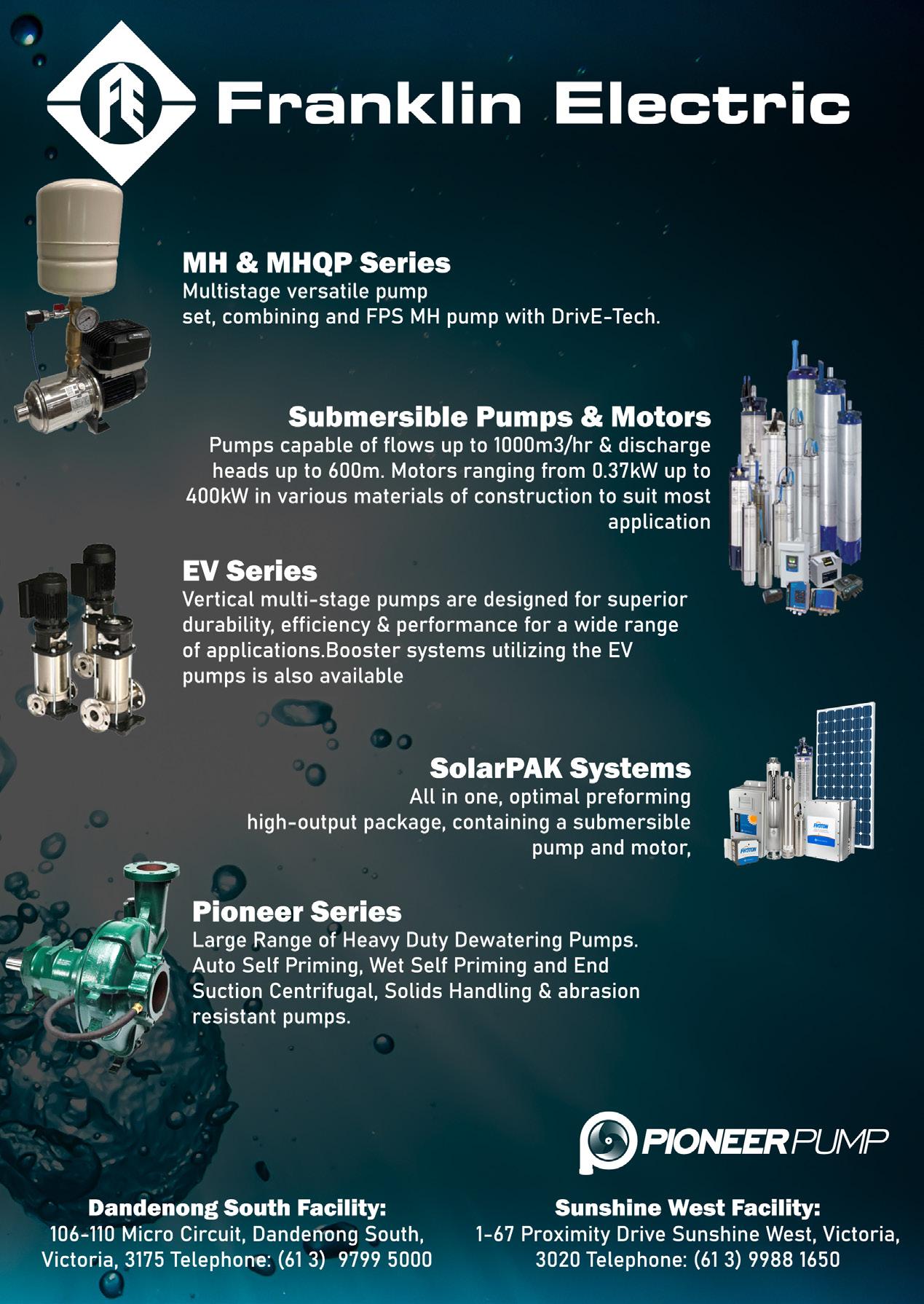




















































































































 Katie Livingston Editor, Pump Industry Magazine
Katie Livingston Editor, Pump Industry Magazine



























































































































